Thinking of the perfect email send can be a challenge. You want to provide value and stay on brand, but you also want to use email marketing as an avenue to promote your business. You want to see a return on investment for all the hard work you and your team put into your marketing efforts. So you need email marketing ideas that are going to help you produce content that excites your subscribers and keeps them informed.
That’s why we’re here to help you get started with a whole slew of ideas to get the gears turning. Maybe you’ll try to add an incentive to sales email, or you might decide to optimize a send with a video, or perhaps you’re ready to venture into the risky waters of contest entries.
Once you understand the types of emails you can use, you can put together a plan to get the results you’re looking for. In this post, we’ll look at email campaign ideas all small businesses can try out when launching email marketing campaigns.
Introducing your business to new customers
Introducing your business to subscribers will help you build brand awareness, instill loyalty and trust, and promote your products and services. Marketing emails like a welcome series and event invitations will grow your contact list and turn subscribers into customers.
Welcome email
Blick Art Materials sends a welcome email to thank customers for subscribing to their email list and includes a coupon code for $5 off their purchase of $45 or more. Follow their lead by creating a welcome email that offers valuable information, familiarizes them with your brand, and encourages them to return to your website.
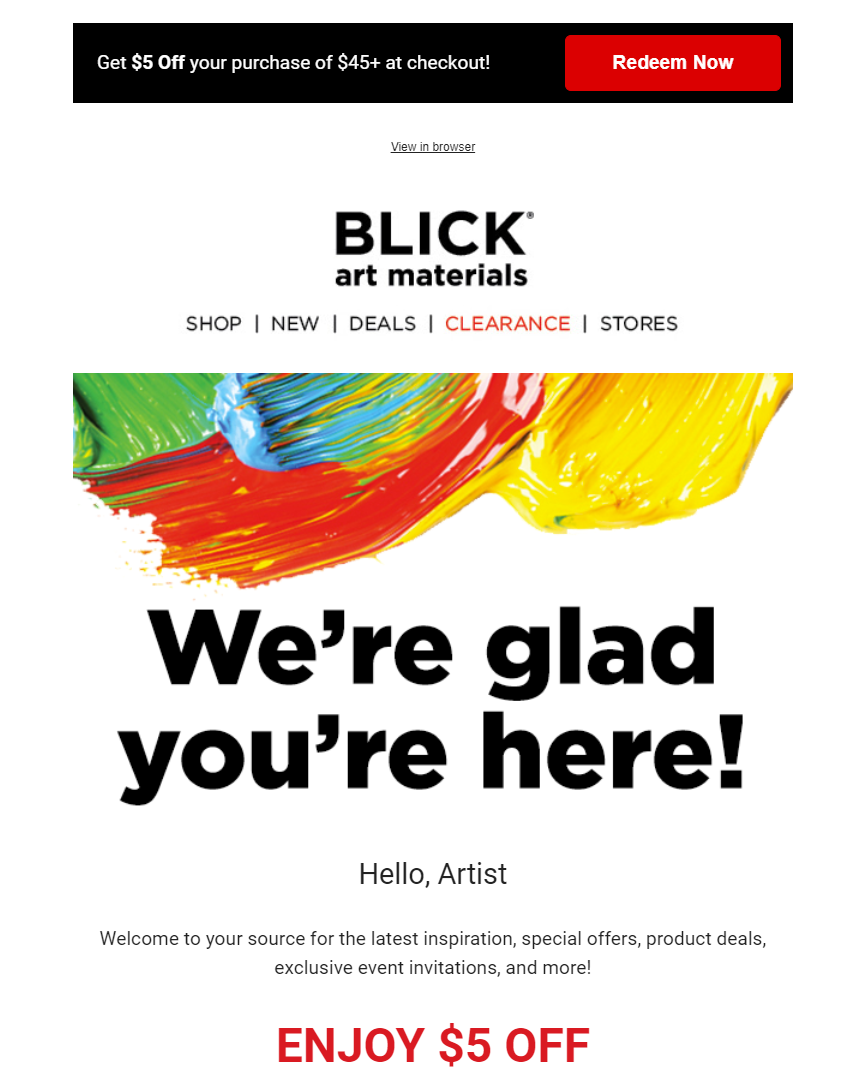
Event invitation
Events are a great way to introduce new customers to your business. Make sure invitations have important details like date, location, and cost. When appropriate, include a link for people to register in advance. Your event invite is also a space to help you advertise your products and services. Add a call to action that directs subscribers to RSVP and consider sweetening the deal with a promo code or gift when they make their reservation.
Event invitations are important for big events and fundraisers but can also be used to get the word out to your subscribers about some of the smaller activities you have going on. Use them to keep your business top of mind.
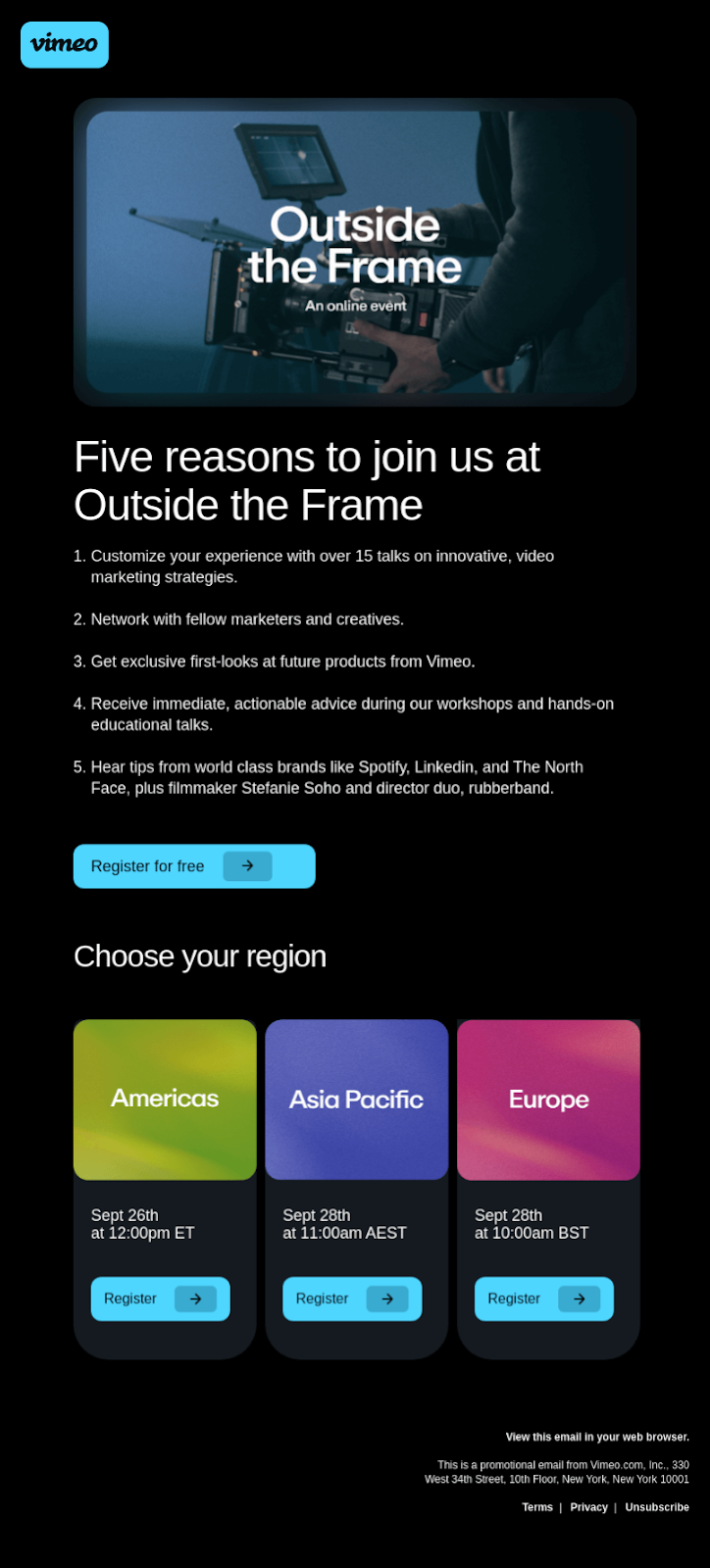
News/Updates
Some of the most important emails your business will send are emails featuring new or revised information about your business. Changes to hours, location additions or store moves, event snafus like rain delays, and regular updates about products and services are all relevant topics to keep your subscribers in the loop.
Update
Your audience is invested in the success of your business. If you have an ongoing project you’ve been working on, a software or policy update, or new products and services to feature, share regular updates to keep people involved and in the know.
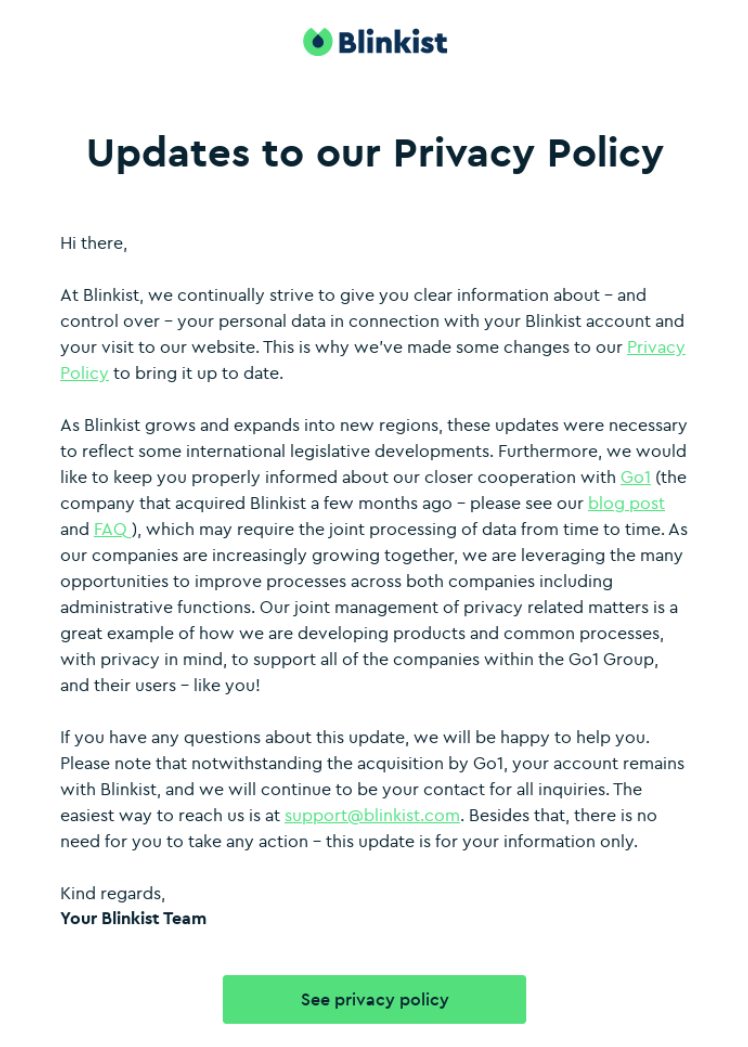
Breaking news
You’re constantly growing and improving your business, and you probably have a lot of news to share. Send an email to inform customers about immediate actions, improvements, or challenges. Take this example from Djusie. They’re using the breaking news format as a clever way to deliver information about their product and to create a sense of urgency.
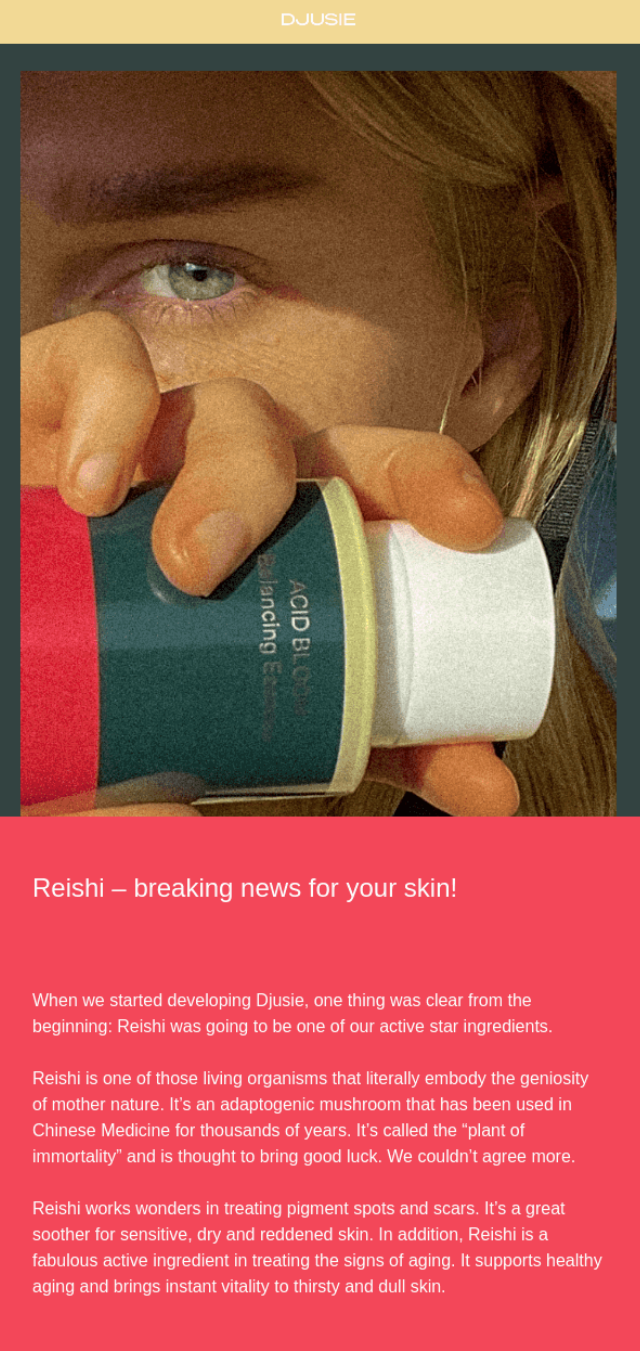
Digest
Make sure your audience doesn’t miss out on the insanely good online content you’re creating by putting together a regularly scheduled email digest.
For example, if you have a blog, you can give readers the option to sign up to receive a weekly roundup of your latest blog posts. Owl’s Nest Farm is a women and locally-owned farm. They send out emails that include links to recipes they’re making.
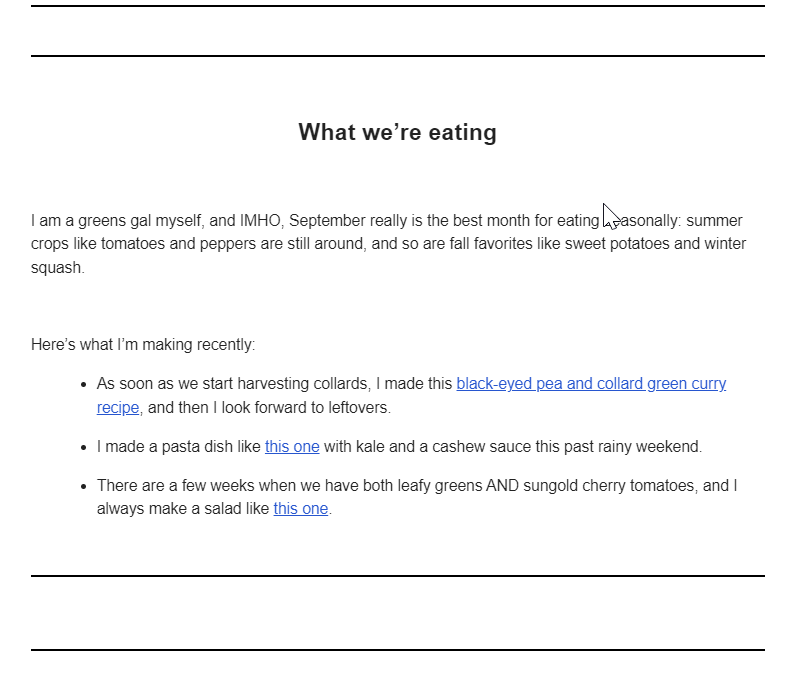
Caption: The email from Owl’s Nest Farm includes a digest of recent recipe content to share with subscribers. Image source: Owl’s Nest Farm
Newsletter
Email newsletters are an effective way for you to give people the information they need in a medium that’s reliable and convenient for them. Your company’s newsletter should include a range of topics, from product updates to changes in business operations to stories from happy customers.
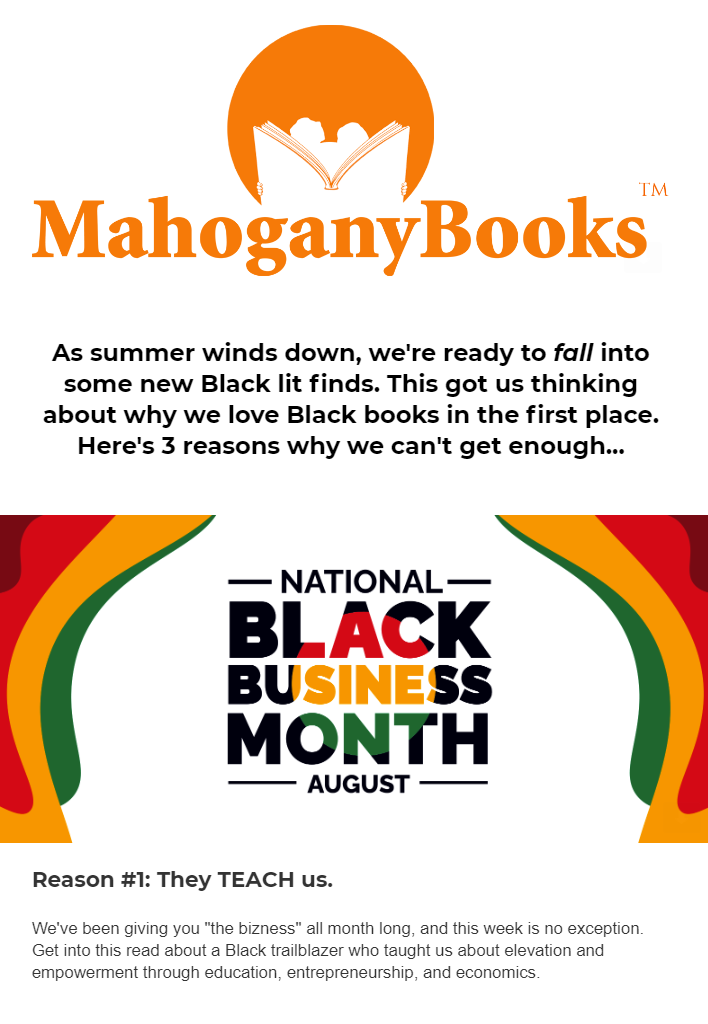
Industry news
You should include an email about industry news in your email marketing strategy to bring your business to the forefront of your industry and prove your expertise. A good example can be seen with the Courier Weekly — a weekly email newsletter that shares stories about modern businesses on the cutting edge of their industries. Boutiques and homeware stores might want to send emails about current fashion and design trends. Restaurants might email subscribers about new advances in cross-breeding produce or flavor experimentations. Whatever industry you’re in, you can use email marketing to set your status as a thought leader.
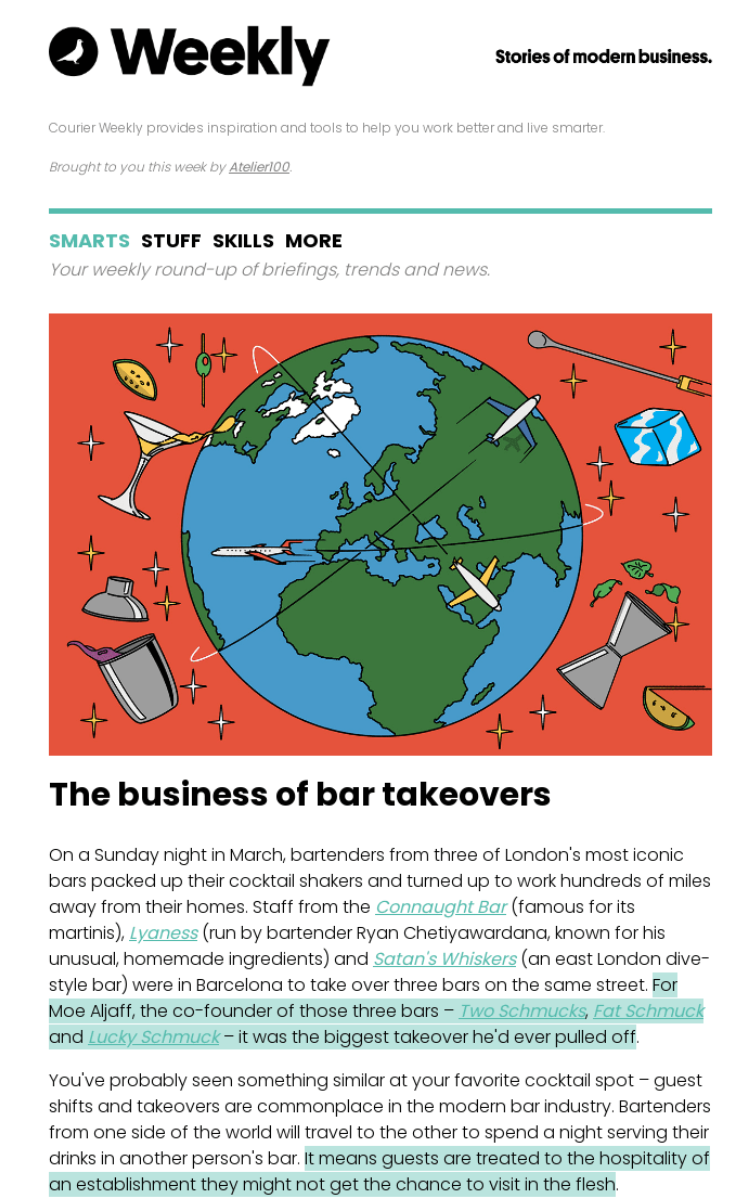
Sales/Product
Emails that promote sales, products, and services will help your business grow your customer base by turning subscribers into purchasers.
Featured products and services
Promotional emails for products and services can go a long way toward driving purchases. Feature elegant product photography and provide specifications, ingredients, benefits, etc. Describe services and how they’ll bring value to customers. This email from Salt & Stone features education on the Endless Santal Body Wash. To entice customers to purchase, it includes:
- A minimalist photo to bring the product front and center
- A clever description
- A call to action (CTA) that directs the reader to “Buy Now”
- A top banner to emphasize free shipping and encourage customers to fill their carts.
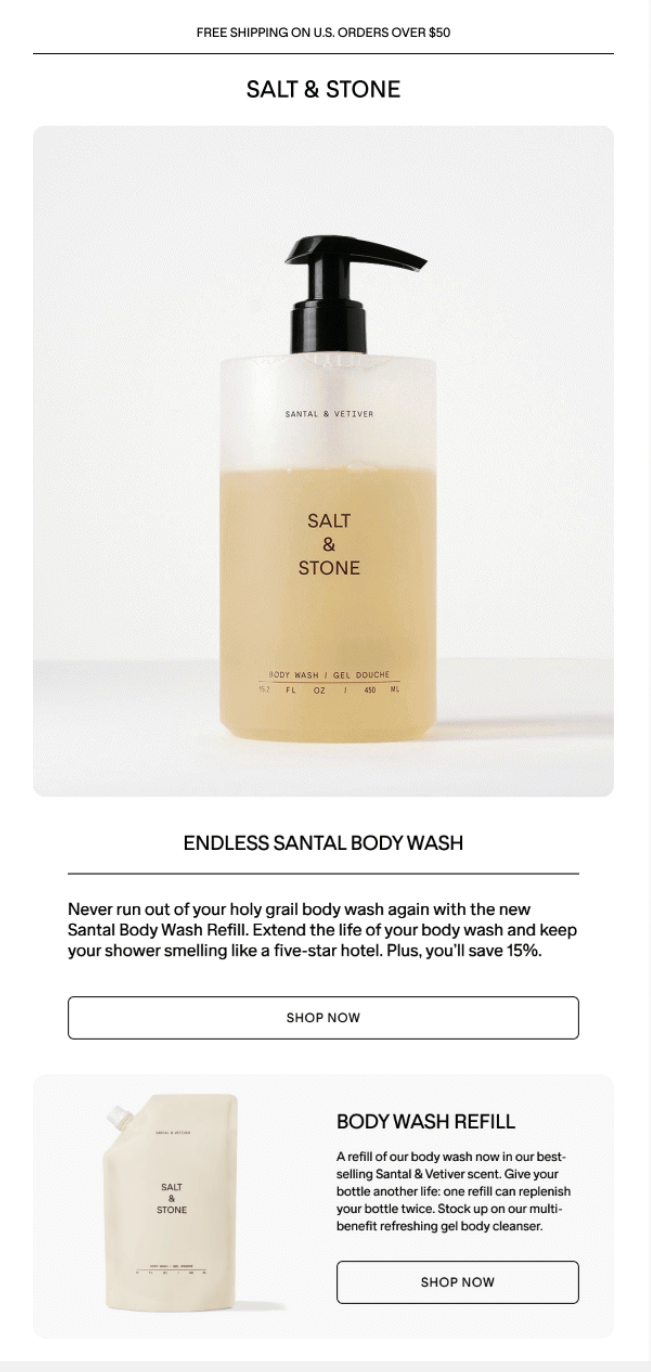
“Best of” and Top-Sellers
Pay attention to your best-selling products and services and send a roundup of what’s turning subscribers into paying customers. Take Misc. Goods Co, a gifts and keepsakes company with local artisans to design and develop quality products. They collect their “best of” products and company memories in A Year in Review.
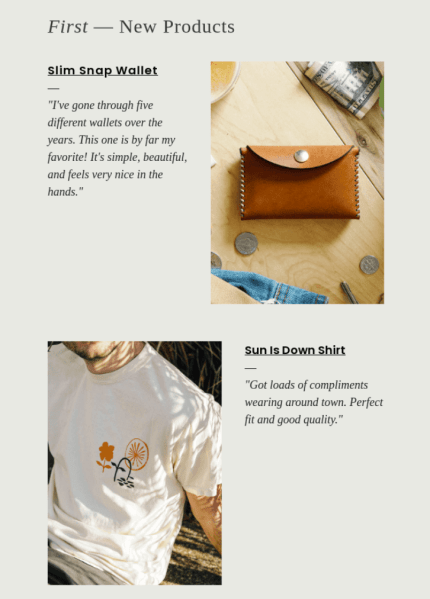
Sale
The power of an email marketing campaign is that it’s immediate. You can create a drip campaign to promote a major sale and send an email blast out in the morning as a final effort to drive shoppers to your store later that day.
Take the opportunity to let your email subscriber list know when you’re offering special discounts.
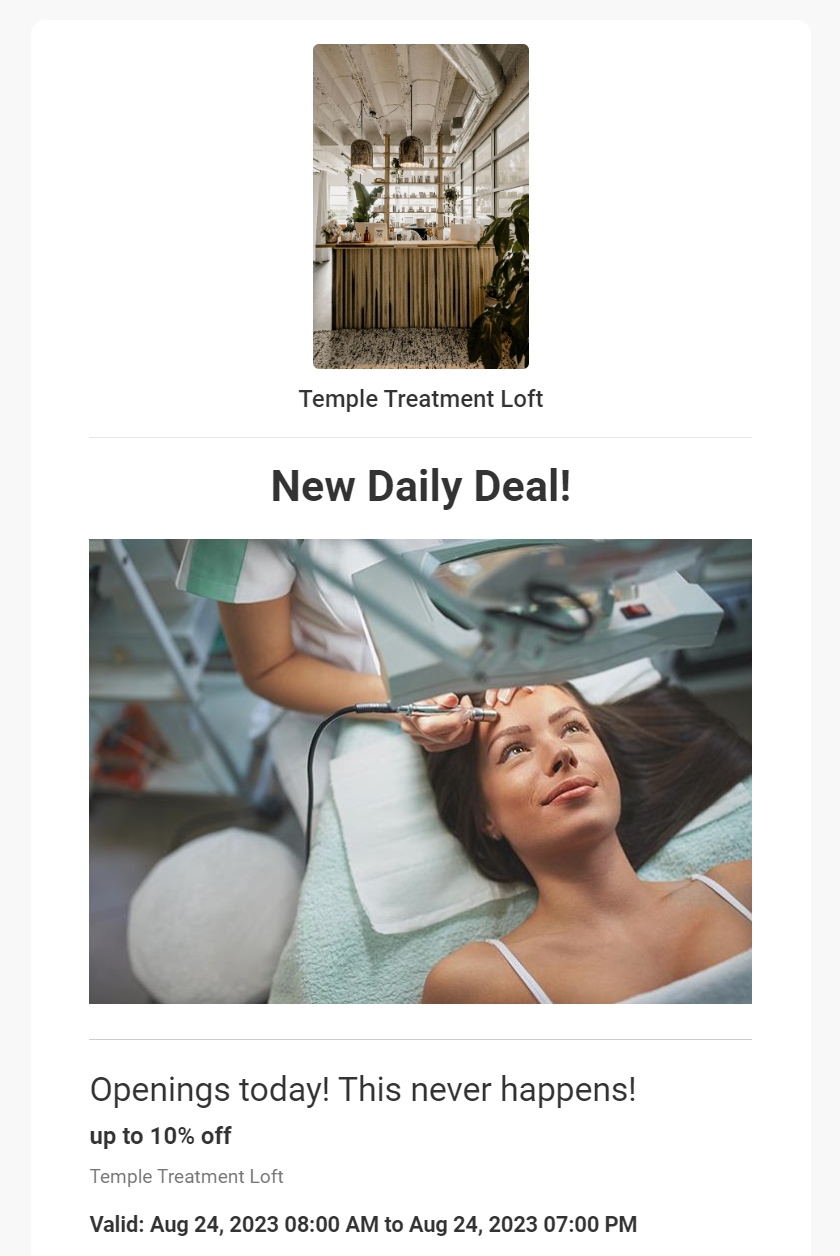
Limited edition
Generate hype for limited edition products and services via email. For inspiration, take a look at this example from Compass Coffee. They’re advertising a limited edition coffee blend they created in partnership with The Washington Post. The email is bold, placing emphasis on the partnership and the product.
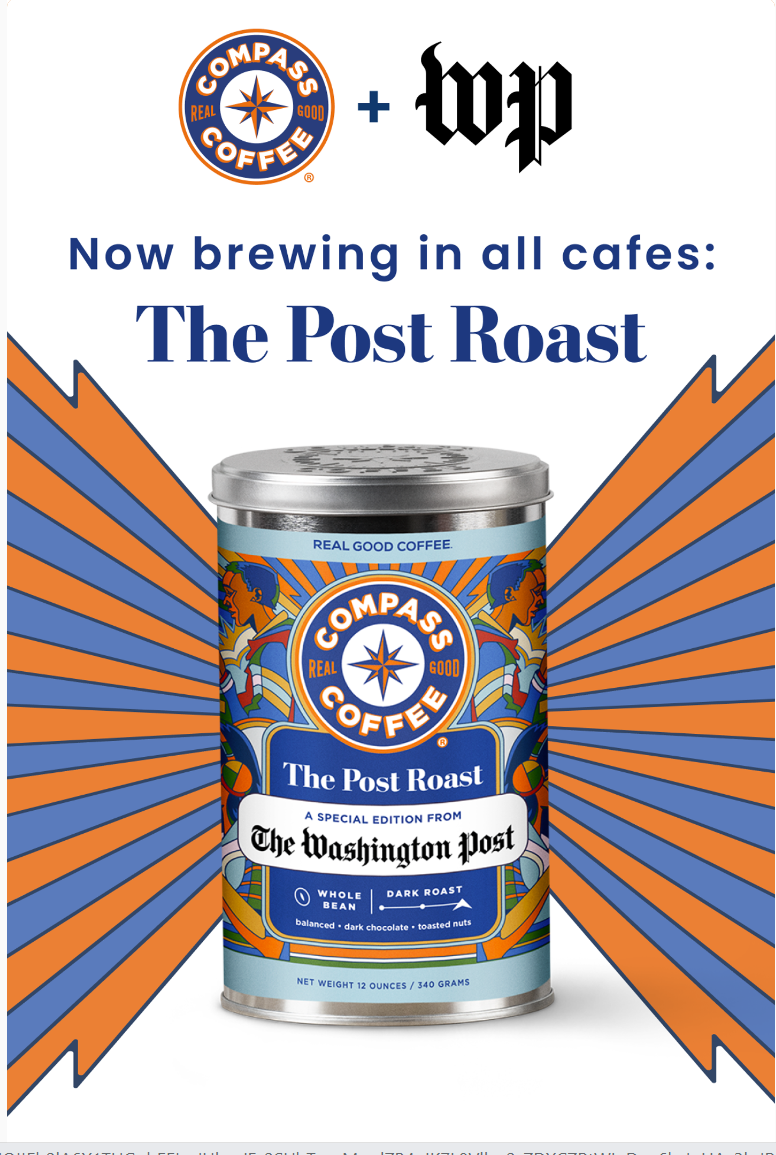
Special gift
No subject line or preheader text generates more excitement than “gift with purchase.” When your business can gift subscribers/customers with a special product, service, or offer, send an email to promote it.
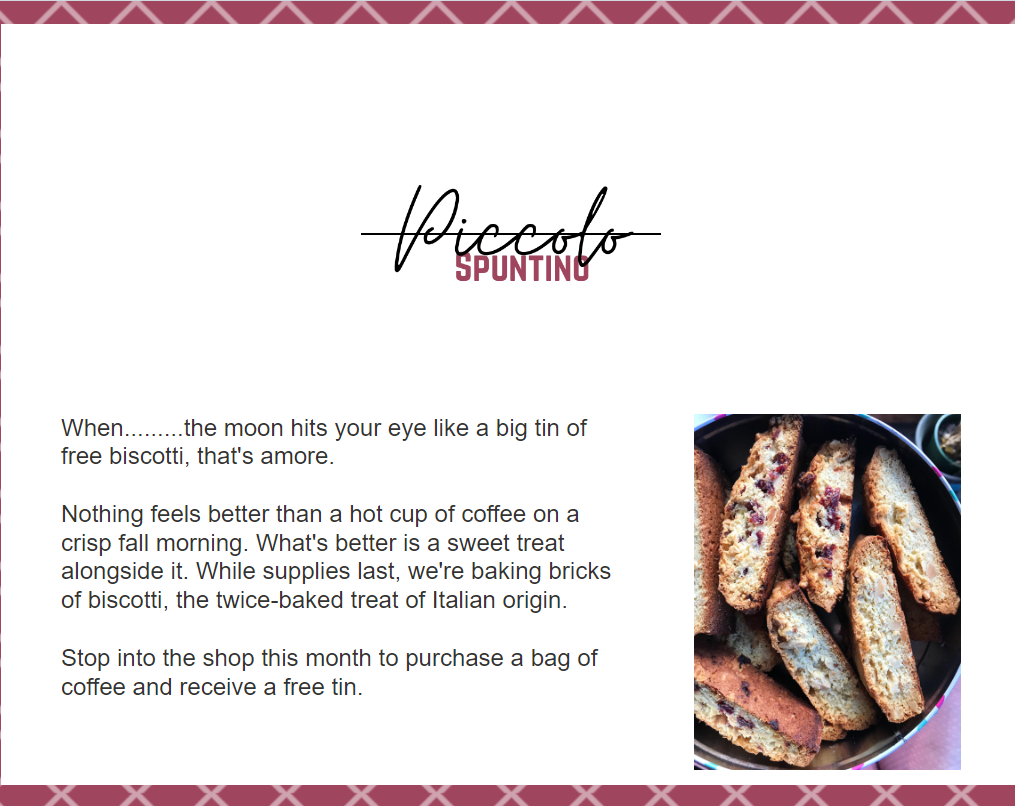
Sneak preview
Your email audience will appreciate access to exclusive information. If you’re adding a new line of products or planning big improvements, send a sneak preview to let people know what you have going on.
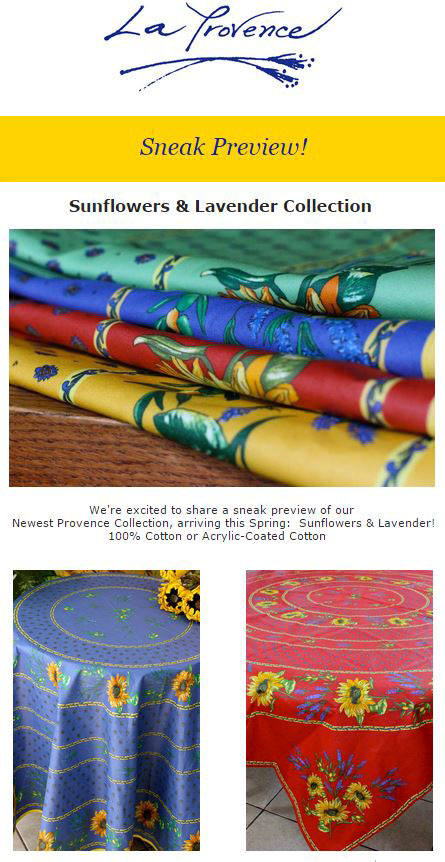
Coupon
A coupon is still one of the most effective ways to boost sales and bring new customers into your store. You can include a coupon in your next email and allow people to redeem the offer right from their mobile device or through a printed copy.
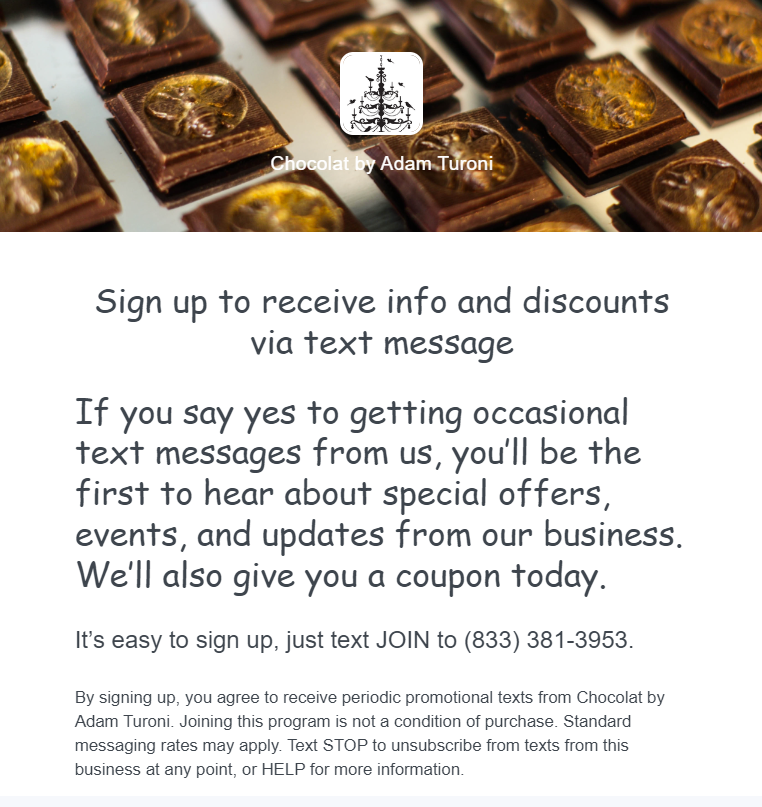
Caption: Chocolat by Adam Turoni sent this email encouraging subscribers to join their SMS Text Message Marketing list to receive special offers. Image Source: Chocolat by Adam Turoni
Video
When used correctly, video can improve your email marketing results and make a more meaningful impact on your audience. Make video the focus of your message or add a video to support the action you want people to take.
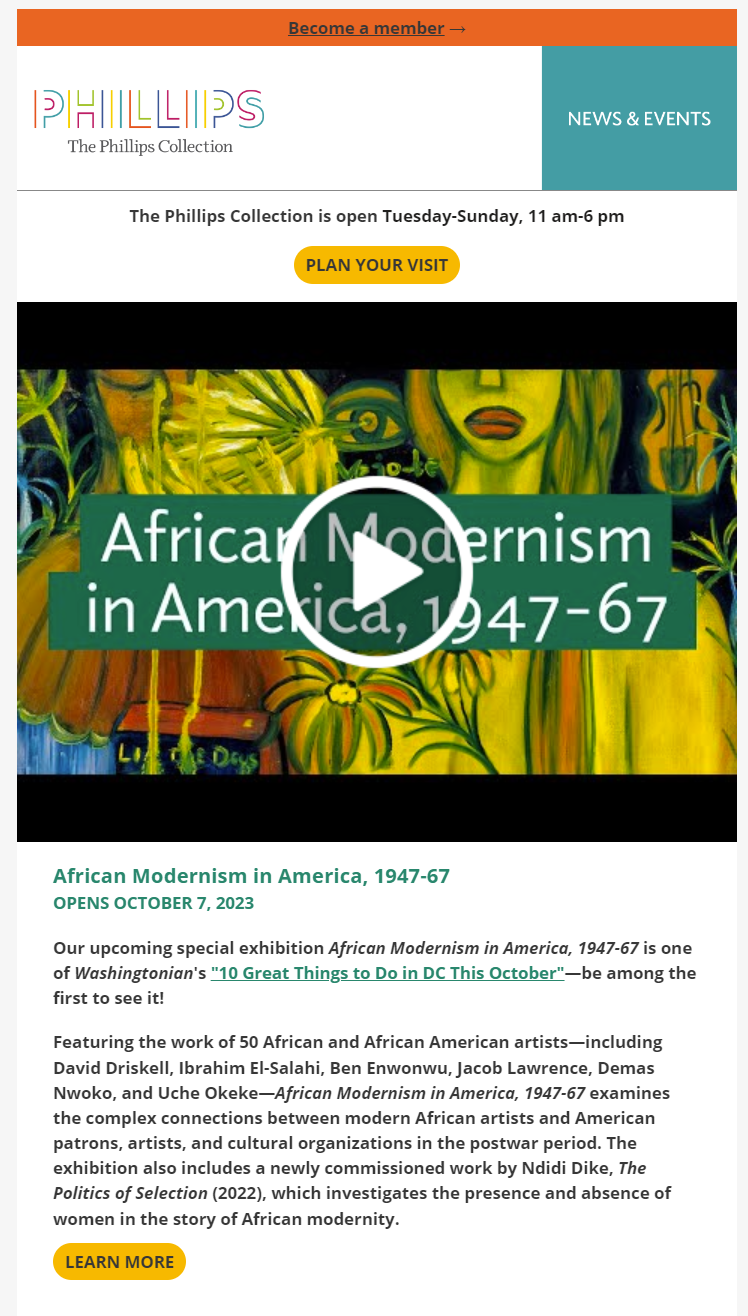
Back in stock
When customers are eagerly awaiting the return of coveted products or service availability, make sure to send an email when you’ve restocked and are ready to accept new orders. Give subscribers the chance to sign up for a segmented email list to be the first to know when what they’re looking for is available.

Seasonal and time-sensitive
You’re going to have email sends that only occur at specific times or are appropriate in a particular season. For instance, you might want to advertise a seasonal event or send well wishes for a special occasion or birthday.
Off-season check-in
Even if it’s not a holiday or your busiest season, you should take the time to reach out to your audience so you can stay connected.
Take RhizomeDC, an art workshop which is open for only open for certain portions of the year. Sending regular emails during the offseason allows them to keep people engaged and bring them back each season.
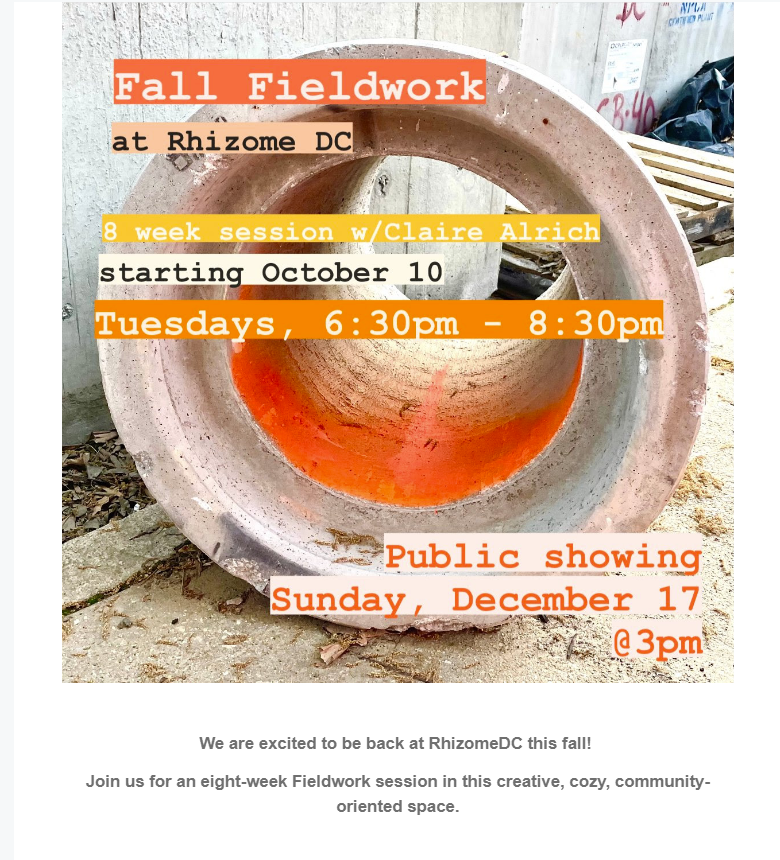
Anniversary
Your customers play an essential role in the success of your business and will be happy to celebrate when you reach a new milestone. On the flip side, it’s vital to appreciate your customers’ loyalty to your business. Perhaps you want to celebrate their first purchase or the anniversary of their email subscription with a special offer or incentive.
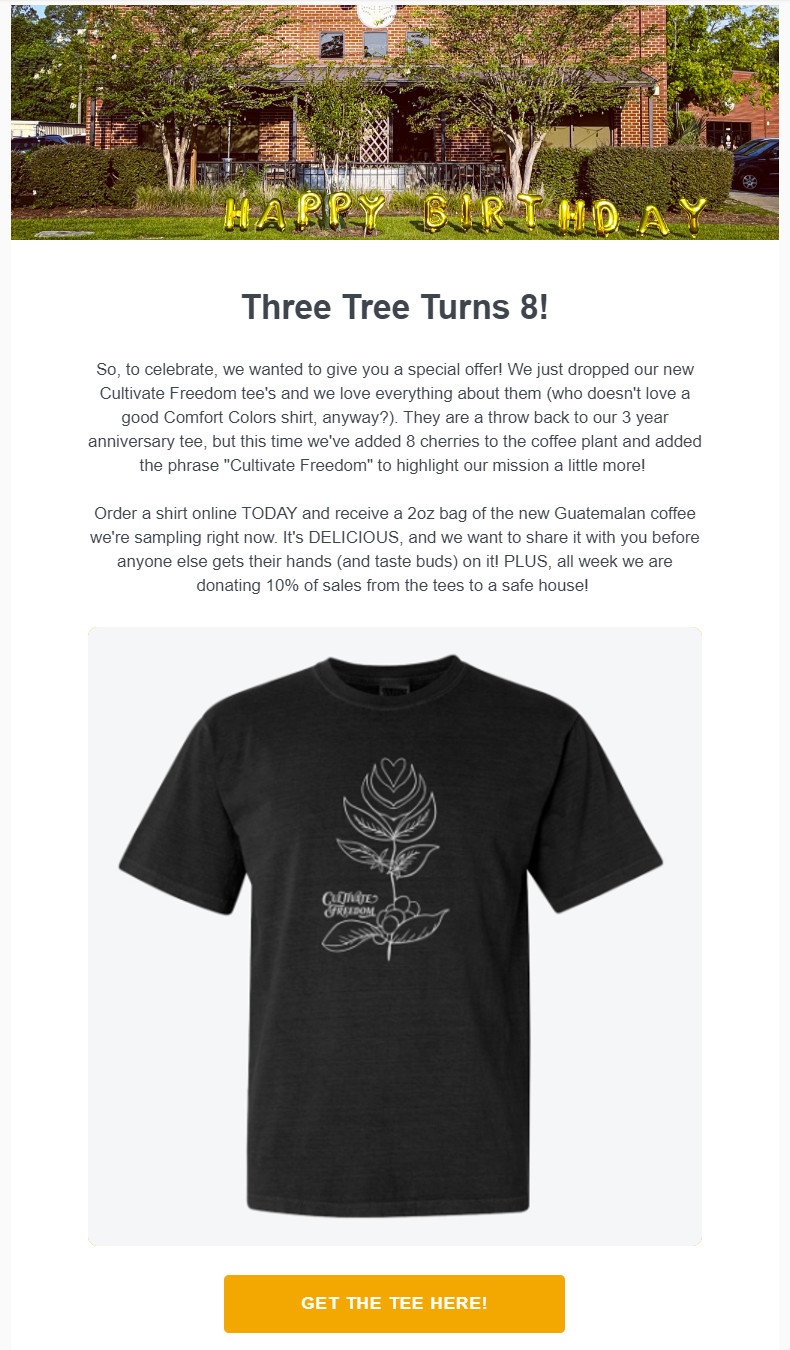
Seasonal Weather
Rain, snow, a seasonal dry spell – if weather conditions impact your regular business hours, send an email to inform customers.
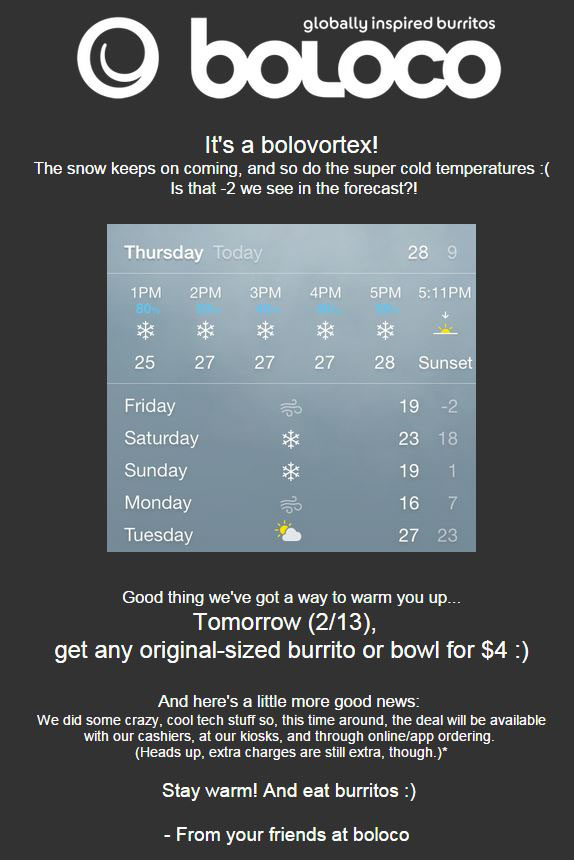
Holiday
There’s no shortage of holidays that you can celebrate with your staff and customers. In addition to the major holidays, there are also some less-serious holidays that customers might want to celebrate with your business, like the ultra-silly and niche International Dog Biscuit Appreciation Day (February 23) or the quaint and wholesome Take a Walk in the Park Day (March 30).
Find other fun holidays and celebrations here.
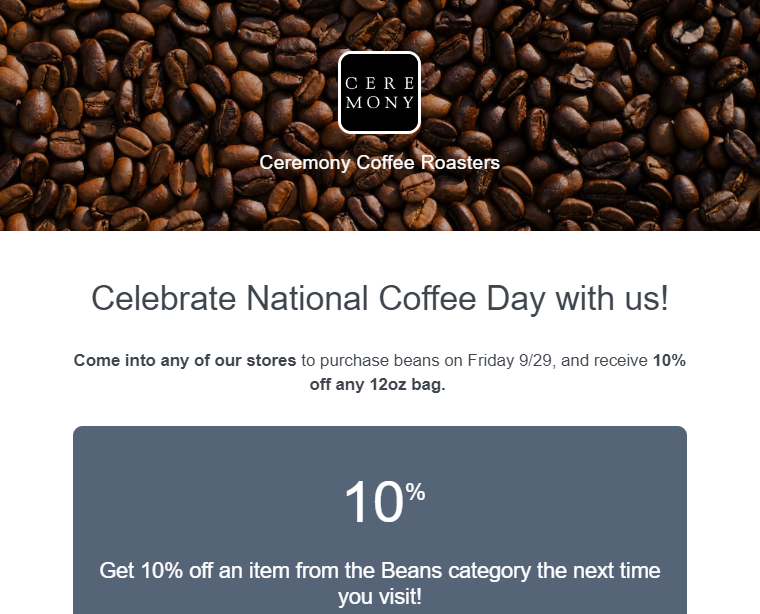
Caption: Ceremony Coffee Roasters sent an email to promote National Coffee Day and included a discount to encourage subscribers to visit a cafe. Image Source: Ceremony Coffee Roasters
End-of-season
Your business will likely have leftover products or specials on services that you’re trying to push at the end of the season. Email makes it easy to showcase items and include special offers to encourage your customers to take action.
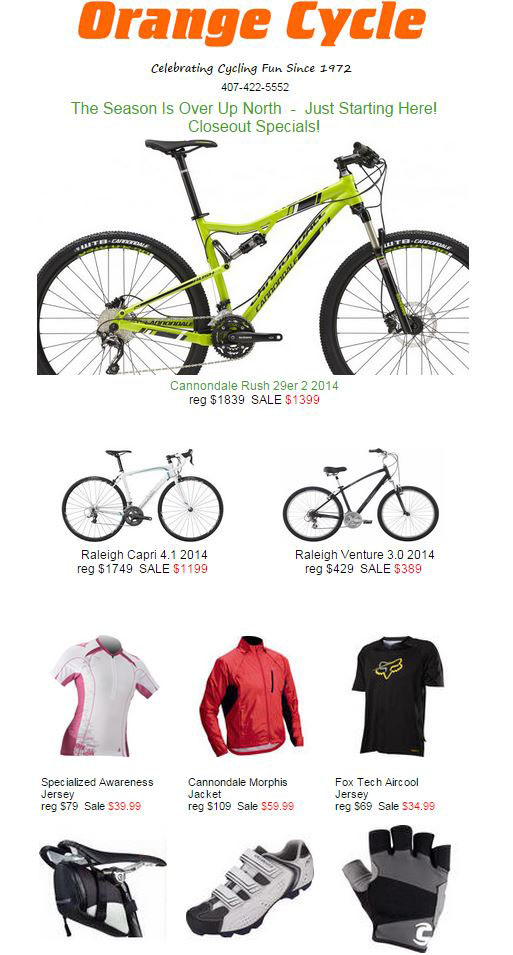
Seasonal event
Even if you don’t have “seasonal” products or services, you can still use the changing seasons to add personality to your messages. Perhaps you’re hosting a fall festival fit with hay rides and apple cider, or maybe you are coming out of the cold with a celebration of spring. Advertise your seasonal events through email to get customers in the spirit and to attract attendees.
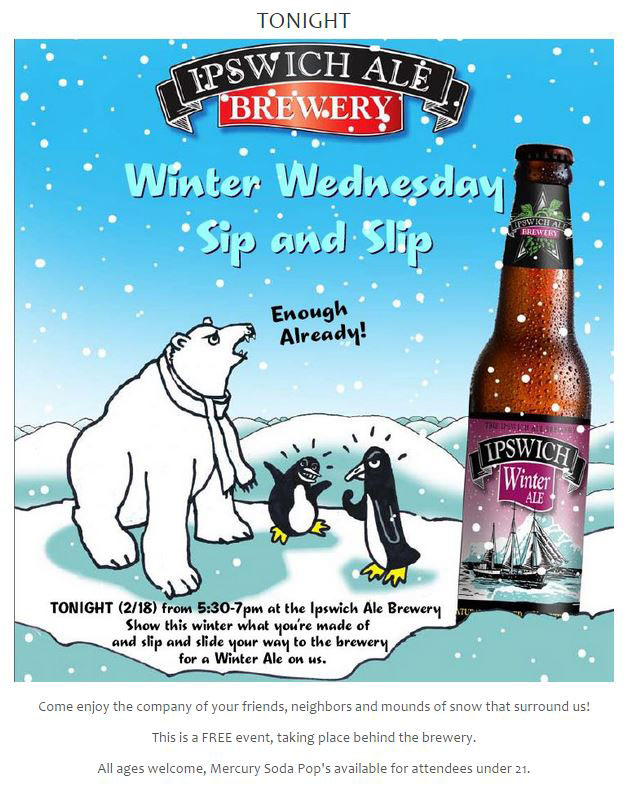
Customer outreach
Customer outreach emails are geared at expressing gratitude, gathering feedback, offering reminders, giving subscribers a nudge to take a desired action, and re-engaging readers who have fallen off the bandwagon.
Thank you
Take advantage of every opportunity to let customers know how much you appreciate them. Send a thank you email to express gratitude for purchases and loyalty shown by your customers and subscribers.
For a business like the award-winning Franklin Cape Ann, a thank you email with a unique coupon was a great way to show customers some love.
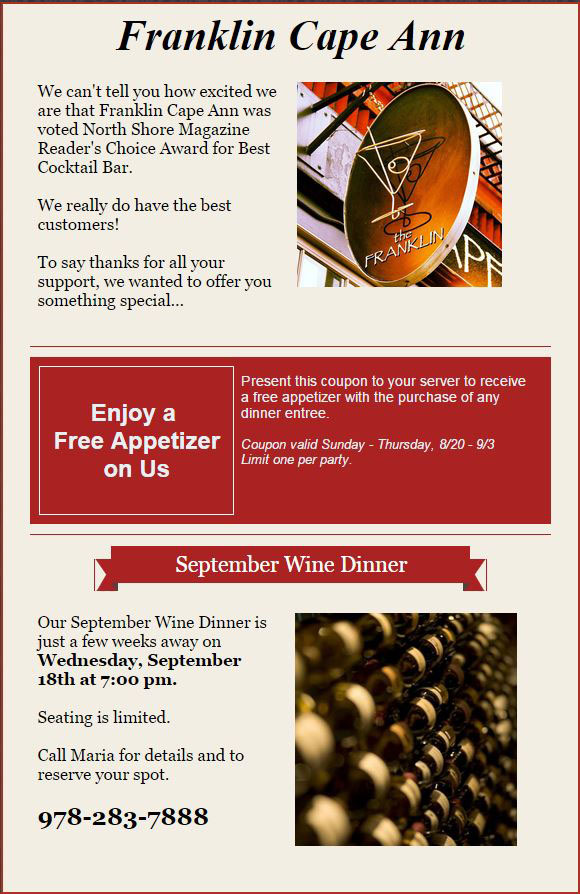
Feedback
Encourage customers to share their thoughts about your business, products, and services by including an online survey in your next email marketing campaign. Keep your surveys short and choose just a few key questions to yield the best results.
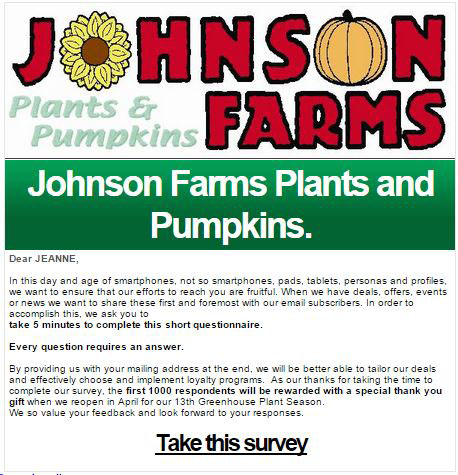
Reminder
Even if you’ve sent announcements and posted about a product, event, or sale on social media, that doesn’t mean potential customers are ready to take action. A lot of people wait until the last minute to take advantage of a special offer, so sending a last-minute reminder could be exactly what customers need.
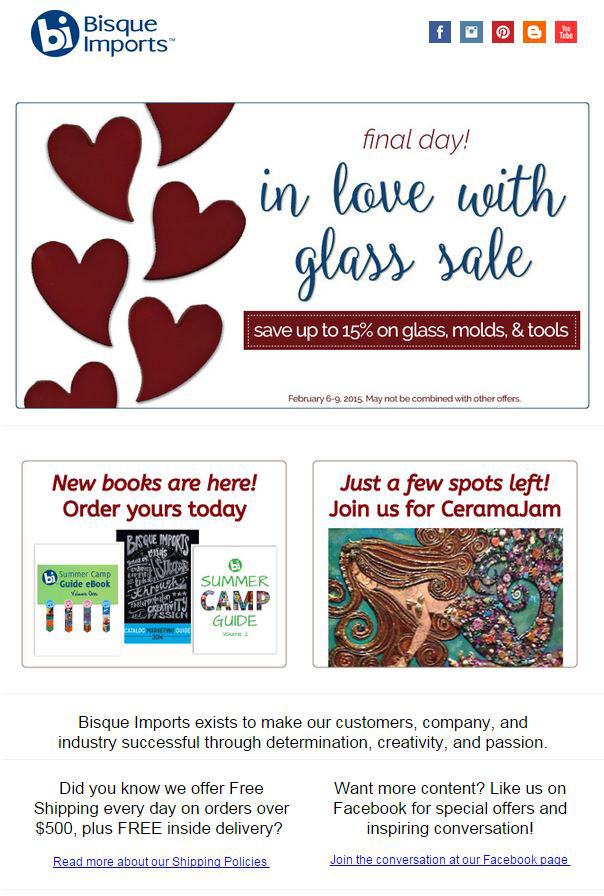
Social
Social media is a crucial element of every good marketing strategy. Ensure your email subscribers know they can connect with you outside the inbox by adding social media buttons to your emails and create a special announcement encouraging people to connect.
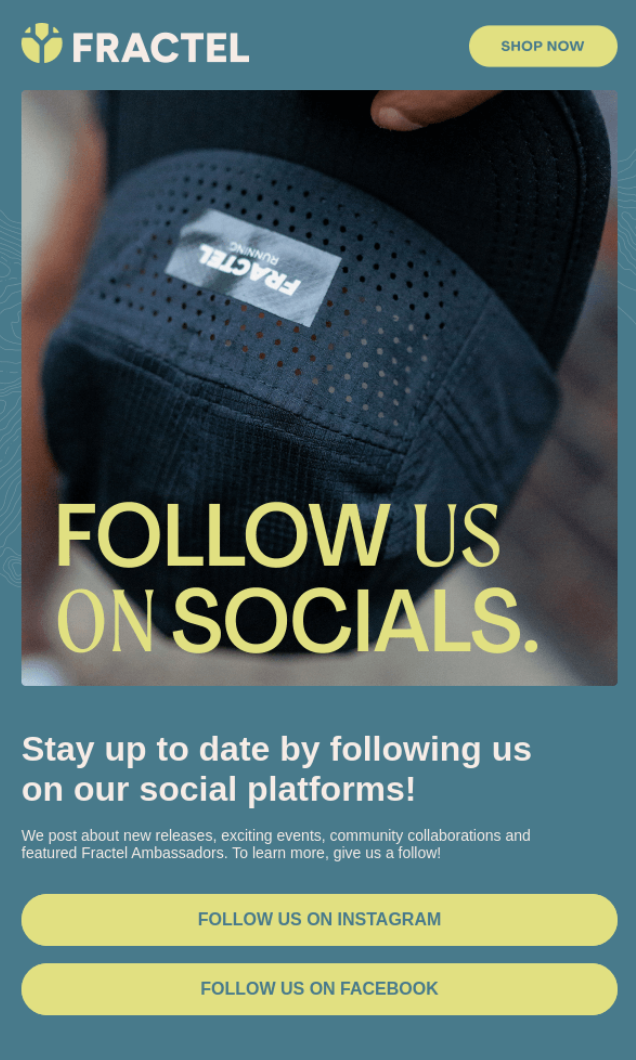
Reengagement
If you have a group of people who signed up for your email list but haven’t been opening your emails, take some time to reach out to see how things are going. Consider adding an engaging subject line to get their attention. Present Company used the subject line “New Beers and Food at Present Company Public House” to reengage subscribers who haven’t stopped by in a while to come try out their new menu.
Learn more about how to reengage customers with email marketing.
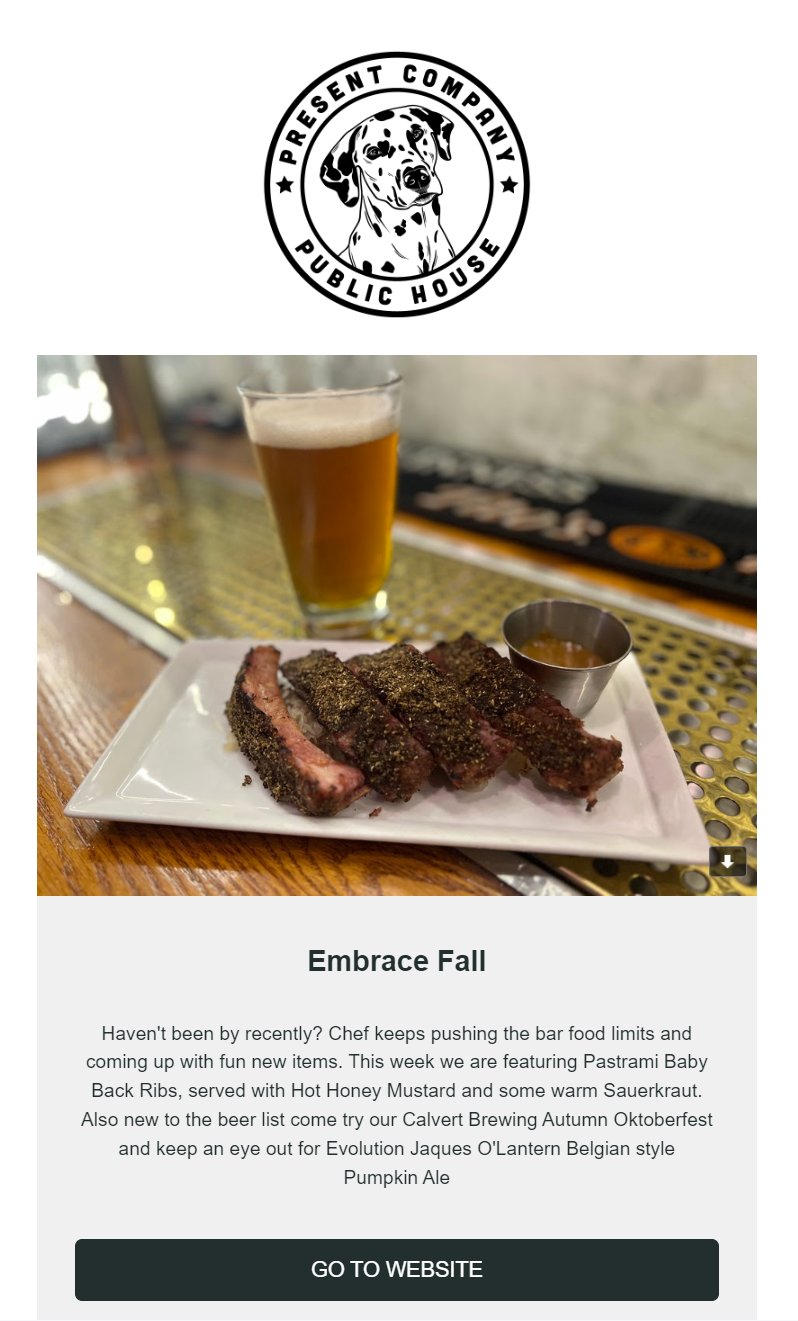
Raffles, giveaways, and contests
Have fun with your audience and encourage them to participate in a contest. You can use a raffle to increase foot traffic and encourage people to enter to win.
Tip: Promote your contest, raffle, or giveaway on social media.

Incentive
Emails offering incentives are one of the simplest ways to reward loyal fans and promote products and services. When you have the opportunity and room in your budget, consider adding an incentive to purchase, like free shipping.
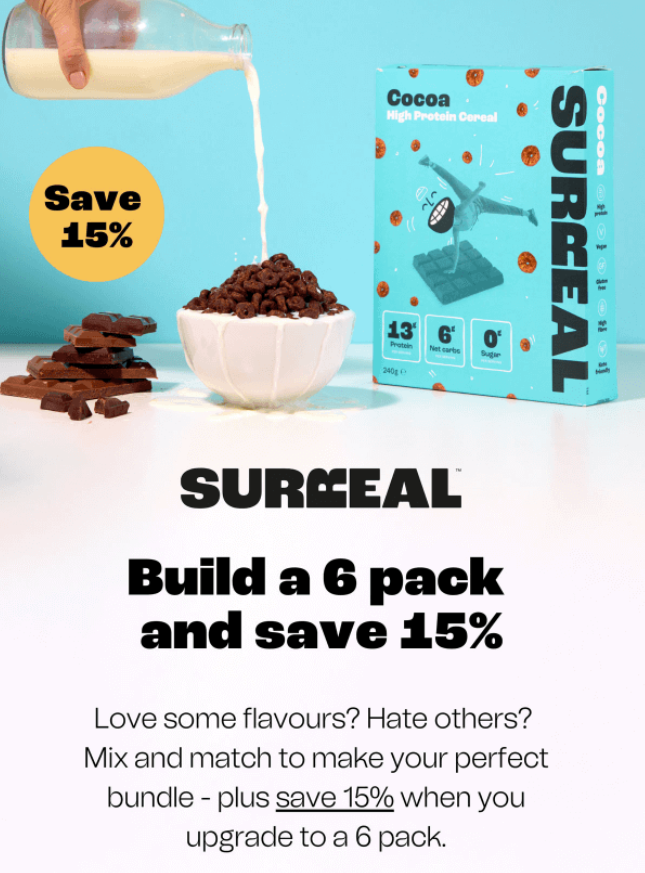
Follow-up
Don’t underestimate the power of a follow-up message. Whether you’re sending pictures from a recent event or connecting with new customers who signed up for your email list — a follow-up email can help turn a new visit into a repeat customer.
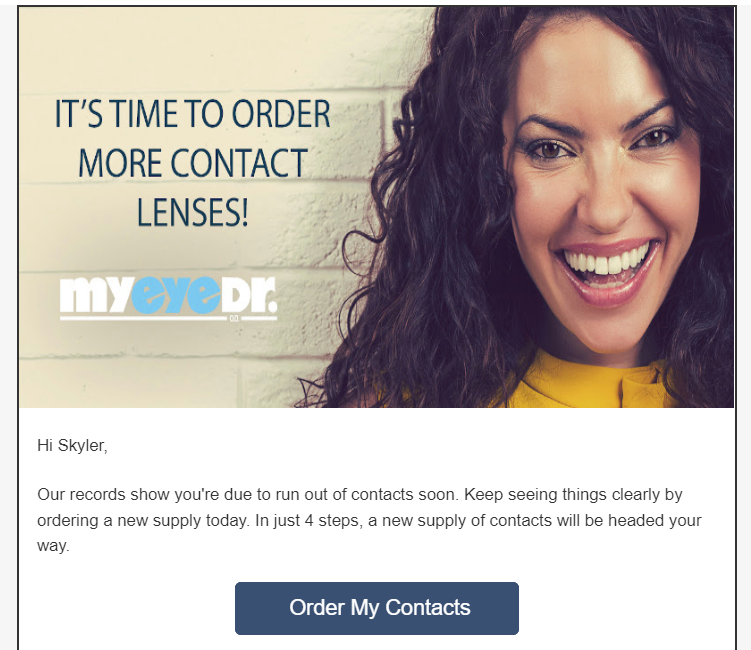
Abandoned Cart
When customers leave their carts before purchase, you’ll want to send an abandoned cart email to remind them of what they’ve forgotten or what they haven’t decided on yet. Include imagery/links to the items shoppers have sitting in their carts and point them in the right direction, aka “Go To Cart.”
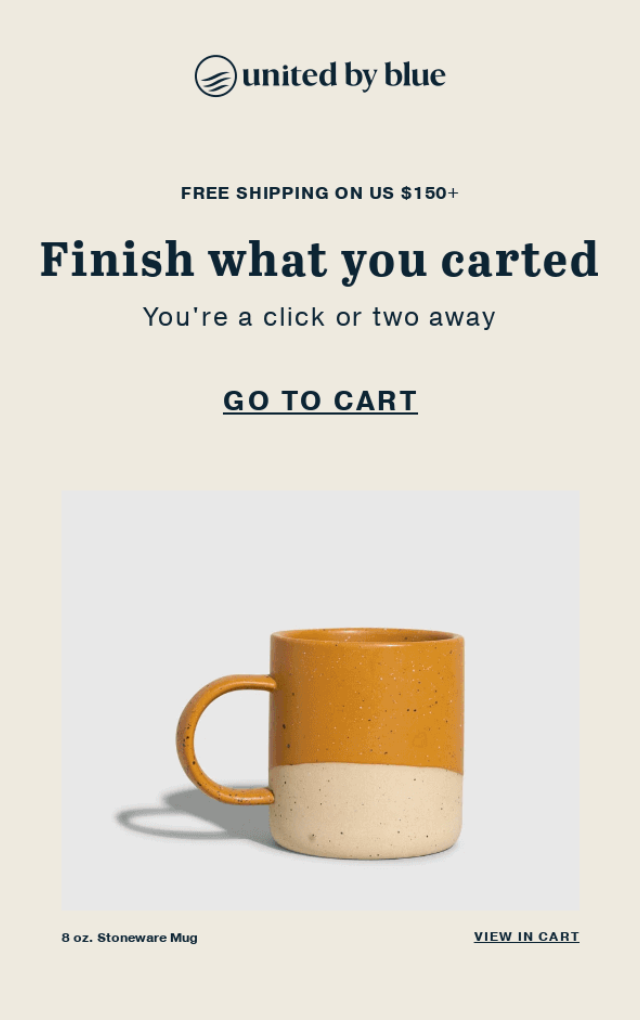
Which of these email ideas will you try first?
Remember these email marketing examples as you start to put together your email marketing plans.
Constant Contact’s email templates make it easy to create effective, beautiful marketing emails, so you can design your content in less time and get back to running your business!
Ready to get started? Log in now.
Not a Constant Contact customer? Start your free 60-day trial today!
Starting a small business is no small feat; especially when you’re working with a small audience. Setting up shop in Collingwood, Ontario — a small town situated in Southern Georgian Bay — Dan Plouffe and Julie Card wanted to find a way to help small businesses connect with their local customer base. With this idea in mind, they started www.mycollingwood.ca, an online portal where local businesses are featured through online listings and event announcements. Over the last decade, Dan and Julie have built the site into a premier destination for people to find the latest news from their favorite local businesses. Success didn’t happen overnight — but with the right tools, Dan and Julie were able to build a dedicated audience and grow a successful business. Here’s a closer look at how they did it.
1. Make it easy for people to sign up
Before starting mycollingwood, Dan had been using Constant Contact at an advertising agency. “It was a no brainer for us to be using Constant Contact right from the start to build our audience,” Julie says. “We already knew it was a really robust and affordable solution.” Dan and Julie started by creating an online sign-up form for people to opt-in to the mycollingwood email list. They then added a link to the form on the mycollingwood website, making it easy for new visitors to sign up. “At first we only had a sign-up form on our website, but once we realized how well it worked for us we’ve added it to our social media sites and pretty much anywhere else we can possibly add it,” explains Dan. By promoting their newsletter on their social media sites and website, they have grown their list to over 4,000 contacts.2. Offer your audience something of value
To spark consumer interest, Dan and Julie hold a weekly special on their site — an offer they call Double Dollars. Every Wednesday, the site features half-off gift certificates to local businesses. Before the deals are available for purchase, Dan and Julie send out a preview email to let consumers know which businesses will be featured the next day. “We’ve been doing the Double Dollars offer every week since 2007,” Dan explains. “And every single week we see the offers sell out within a couple minutes of being posted. The response is unbelievable!” By offering something their audience finds valuable, Dan and Julie maintain a high open rate that averages 40 percent. Their click-through rate is also way above industry average, reaching over 20 percent.3. Use reports to tweak your strategy
Even with impressive email results, Dan and Julie like to check back with their email reports to see where they can improve. “When we send out our monthly newsletter, we send out updates on things like new business openings,” says Julie. “One thing we’ve noticed is that dinning and food listings get three times the amount of engagement as other posts.” Julie and Dan keep track of their open and click-through rates to see which contacts are most engaged and what topics are generating the most interest. “We have a really good understanding of our audience, which helps us shape our content,” Julie says. “We can even look at who read specific posts and target them with future messages about a particular topic,” Dan adds.4. Combine the power of email and social media
As their business continued to expand, Julie and Dan wanted to explore how social media could play a bigger role in their marketing efforts. Knowing they had developed a loyal following on Facebook, they decided to offer a reward to their fans and grow their mailing list. “We were looking for ways to do a social campaign to see what kind of lift we could get,” says Julie. “Increasing our email database was our biggest goal.” To spark interest Julie and Dan ran a special sweepstakes on their Facebook Page for a $50 gift certificate. The results were better than they ever suspected. “We had an overwhelming success with 373 new sign-ups . Our page received 139 new Facebook Likes as well,” Dan says. “I thought that was really significant for just a week-long sweepstakes. We’re eager to try out another promotion again soon.” In total, the offer was shared 44 times and resulted in almost 700 page visits!5. Rely on quality support
Running a fast-paced business means Dan and Julie don’t have time to work through their technical questions on their own. Even as experienced users, they are glad they can call up Constant Contact whenever they have any questions. “I recently had some white space in a newsletter I couldn’t get rid of,” Dan recalls. “So I called customer support and they explained the image needed to be resized and the issue was cleared up immediately. A great thing about Constant Contact is if you’re having a problem, you can just pick up the phone and someone will solve your problem in a matter of minutes.”For Dan and Julie, their small town is their strength.
“We’re in rural North America with a very small audience. But that just means we have to get creative,” Dan says. Creating an online portal where businesses and consumers can connect, and keeping consumers engaged with valuable information and deals, Dan and Julie have made their website one of the most visited sites in town. Think about the ways you can do more to connect with your community. Whether you’re brand new to email marketing, or looking for some ways to improve, choose one of Dan and Julie’s tips to bring into your own strategy. Use Constant Contact to start growing your business today. Start your free 60-day trial. Already a Constant Contact customer? Log in now to create your next campaign.Last week, we hosted our advanced social media webinar: From Just Using Social Media to Getting Real Results. The event covered a range of topics for some of the top social networks — like Facebook, Twitter, LinkedIn, and Pinterest. Throughout the event, attendees had the chance to participate in a live Q&A, where our social media experts answered some of their social media questions. Thanks so much to everyone who attended and for sharing your questions with us. Here’s a roundup of the questions you asked about the top social media networks and some additional resources to help you approach social media marketing with confidence:
This is a guest post from Hal Shelton, SCORE small business mentor and author of The Secrets to Writing a Successful Business Plan. You can read his previous posts for Constant Contact here.You have a business idea, you’ve worked out the operations, and have the funding you need. You’re ready to start a business, right? Not exactly. You first need to form a company from which to run the business. In this post, I’ll take a closer look at the various forms of legal structures to choose from, including: sole proprietorship, LLC, S corporation, and C corporation.
Types of Legal Company Structures
Here’s a summary of the key provisions and implications for the most used company structures. You should consult with a lawyer before making your decision.Sole Proprietorship
This is the only organizational form that does not require an application to a state government. Therefore, it is the default organizational form. You wake up one morning, decide to be in business, and you are a sole proprietor. Of course, you may still need to register your business with the state and/or county, obtain a business license depending on the nature of the business, and prepare other paperwork. As the term “sole” implies, this is an organization with one owner. So a husband and wife cannot be a sole proprietorship.This term relates to ownership and not the number of employees. A wife can be the sole owner and employ her husband and many other employees or vice versa. As there is no personal liability protection in a sole proprietorship, a suit against your business can impact your personal affairs (in other words, a legal suit can end in a claim against your personal assets). While this may sound dire, for many small businesses, there may be few instances when this occurs. When filing taxes for your sole proprietorship, use your personal IRS Schedule 1040 and attach Schedule C (“Profit or Loss from Business”), which, in effect, is a mini business income statement. Therefore, you should account for your business as a separate entity from your personal affairs. On Schedule C, owner’s compensation is not an expense line item because it assumes that the difference between revenues and expenses, meaning net income, is the owner’s salary. It is on this amount that you will be assessed payroll taxes, via Form SE (“Self-Employment Taxes”), and on this amount, you can create a Simplified Employee Pension Individual Retirement Account (SEP-IRA) or a Solo 401K Plan and reduce your taxable income.Limited Liability Company (LLC)
This organizational form has the personal liability protection benefits of a corporation without having all the required administrative and governance procedures. To obtain LLC status, you must apply to a state by submitting an application with an annual fee (each state is different, but it is generally in the $100 to $200 range). With the state-approved LLC, there will be an operating agreement — think company bylaws. These will be the general rules for your company governance. In most cases, the state’s standard operating agreement is satisfactory, especially if you are a single-member LLC. However, if there are several founding members, you will want to review the operating agreement and make sure it fits your situation with an agreement and understanding among the co-owners. This is your operating agreement, so you can model it to your situation. Entrepreneurs frequently select the LLC format to obtain personal assets liability protection. Many start-ups and most “idea” businesses have few assets, so a suit against the company will have no reward and the claimant will try to go after personal assets. But just because you have the LLC paperwork, this will not automatically provide the desired liability protection if you do not operate the LLC as a separate entity. So keep your business separate from your personal affairs — have a separate bank account, credit/debit card, letterhead business stationery, and so forth. Where it becomes more difficult in keeping this separation is in obtaining funding. Often bank loans to start-ups require a personal guarantee and a lien on your personal assets. Some lawyers might argue this is sufficient to say that the LLC is not a separate entity and personal and business interests have been joined. As an LLC owner, there are options on how to be taxed for federal and state income tax purposes. Most entrepreneurs select to have the LLC be considered as a tax pass-through entity and pay the taxes on their personal return(s), since, for most; the personal tax rate is lower than the corporate tax rate. So the LLC will file an information tax return to the IRS (no money is sent) and the owner(s) report and pay their agreed share on their personal tax returns.Subchapter S Corporation
This form of organization has characteristics of both the LLC and C corp. There can be no more than 100 shareholders who are U.S. citizens or residents. Application is made to a state along with an annual filing fee. The subchapter S corporation will have a shareholders’ agreement. These are your bylaws, so design them to meet your needs. You will have a board of directors and the corporate governance processes that apply. As this is a corporation, you can use “Inc.” in your company name, which to some is important, but to me is overrated. In some states, for example, California and Texas, if you are a subchapter S corporation or a C corporation, you must use “Inc.” in your name or otherwise disclose your corporation status so potential customers and vendors know claims against the company will be subject to corporate vs. sole proprietor asset safeguards. Like with the LLC, in an S corp, there are elections to be made on taxation, and most entrepreneurs select to report and pay the federal and state income tax on their personal tax return.C Corporation
C corporation is the legal form of organization adopted by most publicly traded companies. A C corp is a separate legal entity, a “person” under the law. Of all the organizational forms, this one has the most administrative and governance requirements, including a board of directors who have the ultimate fiduciary responsibility. Since the C corp is a separate “person,” it pays corporate income tax. When distributions are made to the owners via dividends, these are taxed to the recipients. The term “double taxation” is used to describe this process.Nonprofit
To become a nonprofit, first apply to a state to be a corporation under its Nonprofit Corporation Act, and then apply to the IRS on Form 1023 for 501(C) 3 or another of the nonprofit designations, and finally back to the state for its certification. While 501 (C) 3 is the most common nonprofit form, under the IRC code in section 501, there are about 25 different nonprofit designations, depending on the type of activities/services provided.Ready to choose the right legal structure for your business?
Selecting a business organization form does not have to be forever. You can start with a sole proprietorship or LLC, and at some future time change to an S or C corp. Key Takeaways- A sole proprietorship is the only form of organization where an application is not required; however it only applies to companies owned by one individual.
- To become a nonprofit is a three-step application process — state, IRS, and back to the state for certification.
- If you want to switch your structure in the future, you can revisit your decision and make the choice that makes sense down the road.
About the author: Hal Shelton’s business planning skills were developed as a certified SCORE small business mentor, corporate executive, nonprofit board member, early-stage company investor, and author of The Secrets to Writing a Successful Business Plan: A Pro Shares a Step-by Step Guide to Creating a Plan That Gets Results. Suggestions for additional topics are welcome; email Constant Contact or Hal directly from his website: www.secretsofbusinessplans.com.
Think about the people on your email list. While some of them have been receiving your email campaigns for years, there’s a good chance others are very new to your business. Or, whereas most of your contacts are local, others may only be in your area a few weeks out of the year.
Effectively communicating with your audience starts with realizing your contacts are not all the same.
If you’re using Constant Contact for your online marketing, you know we make contact management easy so you can stay organized and focused on the parts of your business that matter most to you. You can group your contacts into different lists and add tags to categorize your contacts even further for targeted and effective campaigns. Let’s look at the difference between email list segmentation and tagging, and how you can put these features to use in your own email marketing:Email list segmentation
Rather than sending the same marketing messages to all of your contacts, you can send your audience more relevant content by segmenting your contacts into different email lists. This is especially useful for businesses with a variety of offerings who are speaking to different audiences. Ask your contacts about their interests when they sign up, or send out an online survey to existing contacts to make sure you have a strong understanding of what they’re looking for from you. For example, if you’re running an art gallery that holds regular professional exhibitions, as well as summer art classes for children, ask your new contacts what kind of information they’d be interested in receiving when they sign up. Here’s how a spa segments their email list to ensure their messages reach the right people: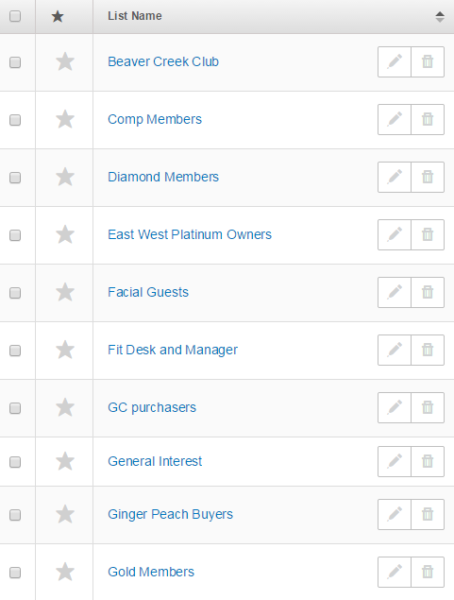 In addition to interests, you can segment your list into different groups based on behavior. Use your email reports to see which contacts are regularly engaging with your emails, clicking on your links, and taking action.
If you have people who are regularly opening and engaging with your emails, you can easily add those contacts to a VIP list that includes your most loyal shoppers or donors. Rewarding their loyalty with a special offer when you need to drive sales, or targeting them with a message about recurring donations ensures you’re reaching out to an engaged audience that will appreciate your message.
In addition to interests, you can segment your list into different groups based on behavior. Use your email reports to see which contacts are regularly engaging with your emails, clicking on your links, and taking action.
If you have people who are regularly opening and engaging with your emails, you can easily add those contacts to a VIP list that includes your most loyal shoppers or donors. Rewarding their loyalty with a special offer when you need to drive sales, or targeting them with a message about recurring donations ensures you’re reaching out to an engaged audience that will appreciate your message.
Tagging your contacts
Tags allow you to classify your contacts even further. While email lists are groups of people you repeatedly want to email, tags allow you to store additional information about your contacts so you can send to an even more targeted group when the time is right. You can tag individual contacts or groups of contacts at a time. Think about what information would be valuable to you. For a business that attends a lot of tradeshows, tags could be useful for keeping track of the location of different audience members. Mother Earth Pillows tags all the contacts they meet at conferences with specific locations, so they can follow-up with a targeted thank you email and reach out to those specific contacts if they are ever back in the area.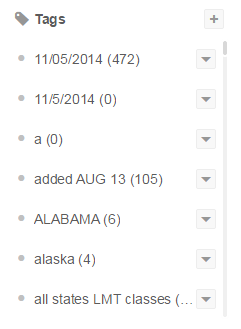 You could also tag contacts by their birthday month and reach out with a special offer at the beginning of each month.
Or, tag by preference or special interest. Do you have certain contacts that want an email every time you get a shipment of a certain product? You can keep track of these preferences easily with tags and send more personal messages to show your contacts just how well you know them.
Your reports can be useful for tags as well. Check back with a recent campaign and tag all the contacts that didn’t open your email. Then, tweak the subject line slightly and resend your campaign to just those that didn’t open it the first time.
Check out our tagging guide for additional ideas and a step-by-step look at how to add tags within your account.
You could also tag contacts by their birthday month and reach out with a special offer at the beginning of each month.
Or, tag by preference or special interest. Do you have certain contacts that want an email every time you get a shipment of a certain product? You can keep track of these preferences easily with tags and send more personal messages to show your contacts just how well you know them.
Your reports can be useful for tags as well. Check back with a recent campaign and tag all the contacts that didn’t open your email. Then, tweak the subject line slightly and resend your campaign to just those that didn’t open it the first time.
Check out our tagging guide for additional ideas and a step-by-step look at how to add tags within your account.
Segmenting and tagging your contact list gives you the power to send more targeted and personal emails.
By paying attention to your audiences’ unique interests, preferences, and behaviors you’ll not only see better open and click-through rates — you’ll gain your audience’s trust by sending messages that feel tailored to them. Start today by brainstorming three different groups that your contacts fall into and creating these new lists in your account.If you’re on social media, you know how rewarding it is to receive positive responses from your fans and followers. But have you also thought about how you can return the favor and show some love back? When it comes to building relationships on social media, a small gesture can make a big impact on how fans view your business and the likelihood that they’ll do business with you again. Let’s take a look at a few easy things you can do to show your fans and followers some love: 1. Mention them After getting home from a yoga class one night, my girlfriend Ashley received a notification on her phone. Her yoga teacher had mentioned her — and a few other people in the class — on the business’s Facebook page, congratulating them on a great class. What may seem like a simple gesture from the studio was really a WOW! moment for Ashley who continues to be one of the studio’s biggest fans. Look for similar opportunities when interacting with your own fans — online and in person. If you have a great conversation with a loyal customer or meet someone new at a local event, use social media to follow up and keep the conversation going.
2. Share their stuff
You want people to share your content so that you can reach a wider audience and hopefully introduce new people to your business. But have you ever thought about sharing other people’s stuff in return? If you’re on Twitter for example, you can share a customer’s post by simply hitting “retweet.” If someone shares a helpful resource or something you think your fans and followers will find interesting, you can share it and include a note calling out the original sources (“Check out this great post from [@Mention them]”). Keep an eye out for other opportunities to celebrate the great work your customers are doing. They’ll appreciate the support.3. Feature them
Your social media presence can tell a lot about your business. If you’re a business that puts people first and values its customers, you want your Facebook Page and other social networks to reflect that. Consider this example from Boston-based burrito restaurant, Boloco. Boloco encourages customers to submit their best photos for the chance to be featured as the cover photo on the Boloco Facebook Page. Encouraging fans to share their photos is a great way to encourage customers to show their passion for your business. Highlighting them on your page in return shows you appreciate their support!4. Work together
If you’re a fan of Constant Contact on Facebook, or follow our updates on Twitter, you know that we love to ask for your ideas to help educate our small business audience. We’re lucky to be able to learn from our customers every day, and want to give our fans and followers the chance to show off their expertise whenever we can. For example, this month we are asking our audience to tell us how they WOW! their customers. At the end of the month, we’ll compile our favorites and share these great stories on the Constant Contact Blog. As a small business, you have the chance to work even more closely with your audience. Look for ways to work together and get them involved in your business.5. Thank them
You know how difficult building an audience on social media can be. You put a lot of work into your Facebook Page and other social networks, and have likely had some challenges along the way. Hopefully the result of all that hard work has been an audience of loyal fans who support your business and look forward to seeing your updates each day. Let them know how much you appreciate them with a simple thank you message like this:6. Be available
One of the easiest ways to show your fans and followers that you appreciate them is simply to be available when they really need you. More and more people are turning to sites like Facebook and Twitter to connect with businesses and get their questions answered. In fact, many people turn to social first, rather than calling a business or sending an email. Take the time to monitor and respond to any feedback you receive. All of the top social networks have the option to receive notifications on your mobile device so that you can respond as quickly as possible.7. Reward them
There are a number of ways you can reward loyal fans and followers. One of the simplest things you can do is to make your social networks the go-to place for relevant content and information. When you give your audience the information they want, and don’t clog up their feeds with irrelevant messages, you’re already rewarding them in a big way. Take things a step further and create a special offer just for them. You can post a simple thank you message and tell your audience to “mention this post” to redeem an offer. Or, use a tool like Constant Contact’s Facebook Promotion campaign to create a coupon fans can print out or show on their mobile device.Ready to show your audience some love?
Choose one way to show your customers some extra love before Valentine’s Day. What may seem like a small gesture to you, can make a lasting impact on new fans and loyal customers. How do you WOW! your customers on social media? Share your ideas in the comments below.It’s easier than ever for nonprofits to stay connected with the people who matter most to their organization.
While newer technology has brought some enormous benefits, it also comes with challenges.
Marketers need to consider widely different channels to reach all the right audiences. Besides that, they need to stand out. Social media, video, microsites, paid ads, search results, and email are saturated with messages from marketers.
Many of the newest marketing channels are proven innovative communication tools, but email remains a pillar of effective marketing. 99% of email users check their email every day. That’s why email marketing should be at the center of your nonprofit’s outreach efforts.
The best email marketers enjoy a high return on investment (ROI) for their efforts by running targeted, creative, thoughtful campaigns.
Benefits of email marketing for nonprofits
Cost-effective communication
The majority of nonprofits and charities have a minimal budget to allocate to marketing, so it can be a challenge to figure out where to spend your dollars. Social media has the lowest barrier to entry because it’s free to create a business account. Costs can incur if you decide to invest in scheduling software or paid advertising. On the expensive end of the spectrum, you’ll find print marketing and TV advertising. Email marketing finds itself in the middle in terms of cost but has an ROI of $36 for every $1 spent, so you can be sure your organization’s budget is being spent wisely.
Build and nurture relationships
Ask supporters of your organization to subscribe to your email marketing list. Turning supporters into subscribers keeps them in the loop about your organization and lets you nurture supporters’s and sponsors’s relationships to your organization and cause. Email marketing is also a great way to promote your organization’s social media channels — allowing people to connect with your organization on a more immediate level.
Raise awareness and educate supporters
Email marketing is a great way to keep your audience informed about your organization and cause through regular email newsletters and educational materials. Let your supporters know where their dollars are going and how they are being used by sharing impact reports, stories, statistics, and the goals your organization is striving toward.
Promote events
Nonprofit organizations thrive on hosting events. Events promote shared experience and shared experience promotes shared giving. It can be hard to feel like you are making a difference when you are donating as an individual. Events give organizations and supporters the opportunity to see the impact they are making as a community of people supporting one cause. Use email marketing to promote future events and recap past events to keep momentum strong.
Reach fundraising goals and collect donations
Create a drip campaign to encourage donations and let subscribers know how close your organization is to reaching your fundraising goals. A drip campaign is a series of emails sent periodically to subscribers to direct them toward an end goal. Drip campaigns, in terms of fundraising, work to encourage initial donations and even supplemental ones when subscribers see an organization is close to reaching the finishing line.

Track and measure results
Using an email service provider (ESP) will help your organization easily track and measure the results of email marketing campaigns and their effectiveness in encouraging donations and engaging subscribers. Track open rates, click-through rates, bounces, and your subscriber count to understand where your marketing strategy can improve. Check the average open rates, click-through rates, and bounces for nonprofit organizations — updated here monthly.
The five W’s
Take the time to map out the who, what, where, when, and why of your email marketing strategy.
Who should I email?
It might be tempting to answer this question with “Everyone on my list!” But if you want to improve donor retention and develop more meaningful donor engagement, you have to deliver the right message to the right person.
Email marketing is one of the most effective channels for communicating with different audiences.
Rather than sending one broad message to your entire email list, email list segmentation can help your organization to create email campaigns that are specific to your audience.
Here are some ideas for email segments to get you started on your own nonprofit email list:
- Blog subscribers who have never donated before
- Re-engagement campaign — speak directly to those who’ve impacted your nonprofit in the past
- Donation amount
- Monthly recurring donors
- Social media power users
- Corporate sponsors
- Volunteers
What content are you sending?
It’ll be much easier to answer this question once you’ve segmented your email list. Each segment of donors or fundraisers should get content tailored to them. This means that first-time donors might receive educational material on your cause, while recurring donors get more detailed impact reports.
Think about the message from your supporters’ perspective. Given your relationship with an organization, what kind of information or appreciation would you expect from them?
Tip: Make sure to craft compelling subject lines for your organization’s emails to encourage opens.
Welcome emails
Welcome supporters to your organization’s email subscription. Let subscribers know about the content they will receive, when they can expect to hear from your organization, and if your organization offers incentives or gifts as a thank you for making a donation. Include educational material to let them know about your organization’s cause and thank them for subscribing and supporting.
Fundraising emails
Fundraising emails are a core piece of a good nonprofit marketing strategy. Fundraising helps to support the cause of the organization alongside the organization itself. Make sure your organization sends branded, informative emails with clear calls to action to boost donations and turn donor and membership statuses.
Thank you emails and donation confirmations
Thank your organization’s supporters for donating and for attending events. Thank you emails and donation confirmation emails should be timely. The messages you send go a long way to let your supporters know that your organization appreciates their generosity, time, and loyalty to your cause.

Education and impact
Email educational materials to your audience to keep them informed about new developments and impact regarding their support of your organization’s cause. Include stories about who or what is benefitting from donations, as well as future goals to promote continued donation and involvement with your organization.
Newsletters
Send regular newsletters to keep subscribers informed about your organization, upcoming events and fundraisers, incentives and gifts, and recaps and stories. Use newsletters as an opportunity to have subscribers revise their donor status (think one-time donor to recurring, or standard to premium memberships) and to promote opportunities to get involved.
Promote events and send recaps
Promote events via email and direct subscribers to RSVP. Create drip campaigns to create hype for subscribers who have signed up for your event and to encourage the people who have not signed up to submit their response before it’s too late. Send recaps of events to non-attendees and thank-you’s to the people who attended your organization’s event. Send recordings from virtual events like webinars, panels, and discussions to event attendees and non-attendees, alike.
Event volunteers, sponsors, and partner stories
Partnerships and event sponsors help to grow your organization’s network. Share stories and impact from nonprofit event sponsors and partners with your organization’s subscribers. Encourage subscribers to follow nonprofit partners and attend sponsored events.
Where are you directing your readers?
Of course, you want your email’s content to be engaging to your readers, but they should also receive clear direction as to what to do next. If the email is only going out to your newsletter subscribers, the main call to action (CTA) might link out to a blog post. On the other hand, if you’re running a recurring donations campaign, link out to the campaign microsite or a donation form.
Tip: Make sure to connect what you’re emailing to what readers find on the other side of the CTA.
When should you send emails?
In some cases, the best day to send email is on the weekend, while in others it might be a Monday or Tuesday. Ask yourself who your audience is and what their primary behaviors might be and start experimenting. By looking at your reports, you’ll eventually be able to determine what days and times receive the best open and click-through rates.
Note that the peak times for open rates can be different than primetime for click-through rates. Choose the send day and time based on data you’ve collected from previous campaigns. For example, send an email with a CTA to donate during the final push of your fundraising campaign on the day and time you’ve observed higher click-through rates. Check conversion rates to see how many people made a donation after clicking on a link to a donation form in your email.
Tip: Craft a content calendar to keep your organization’s communications organized and to avoid overwhelming your subscribers and social media followers.
Why are you sending emails?
This might be one of the most important questions you ask yourself before sending an email or starting a campaign. Remember, the most effective marketers reach the right people, at the right time, with a relevant message. Create specific goals, by segment, for your email campaigns and the content you deliver to supporters will be much more compelling. Some reasons your nonprofit organization might be sending emails include:
- To gather donations
- To inform your audience
- To organize events
Here are some examples of how you can use the five W’s in your nonprofit email marketing plan:
Who? First-time donors
What? An educational infographic that reminds them how important their donation has been to solve a problem in your cause sector.
Where? Send email recipients to a blog post or a video that elaborates on the information in the infographic.
When? Within a week of their donation.
Why? Demonstrate a donors’ value to your mission and motivate them to re-engage with your organization.
Who? Donors who have supported your organization multiple times
What? An exclusive invite to be the first to join your brand new recurring donors program.
Where? To your unique recurring donations program page or form.
When? During the soft launch of a recurring donations campaign or during your year-end campaign.
Why? Make dedicated donors feel appreciated, so they become a pillar of sustained support for your organization.
Who? One-time donors
What? A celebratory thank-you message with a soft ask to donate again
Where? Send them to a unique donation form that speaks to this segment. Maybe the headline of the form is, “Congratulations! You’re about to renew your impact!”
When? On the first anniversary of their first donation
Why? Increase donor retention through celebration and positive reinforcement.
Nonprofit email marketing best practices
Mobile-responsive design
Make sure your organization’s emails are responsive on mobile devices. Emails must fit the frame of the device they are being read on without content and calls to action being cut off. Content needs to be clickable and scrollable by touch and fit a range of mobile devices and web browsers/apps.
Social media links
Emails are an opportunity to share your organization’s social networks and expand your reach. Link your organization’s social channels within your email and write a call to action to direct subscribers to follow your accounts.
A/B testing
A/B testing involves selecting an element of your email campaign to be variable. Create two versions of the selected variable to test against each other.
Common A/B tests include:
- Testing subject lines
- Email layout
- Images and graphics
- Color
- CTA text
- Link type (including buttons, hyperlinks, and linked imagery)
Form test groups of similar size and demographic make-up to control the test.
Call to action
A call to action (CTA) directs a reader to take action. Calls to action are placed on websites, in emails, and on social media and accompany a button or link to a product page, landing page, subscription form, event sign-up, etc.
Gather donations and engage supporters with email marketing
Whether you’re running a fundraising campaign, sending a monthly newsletter or preparing a one-off email, Constant Contact has the tools to to support all of your email marketing needs. Sign up for a free trial and test out our email builder, list segmentation feature, and check out the reporting dashboard to see how you can progress your strategy and boost subscriber engagement.
Have you ever come across a business that really seems to understand you? They not only have the products or services you’re looking for, but they also have something else that makes you walk away feeling like, “Wow! This business really gets me.” This is an example of a WOW! moment and is often the first step to building a customer relationship that brings long-term benefits to your business.
Providing that type of experience starts with being able to connect with customers in a more personal way.
One-size-fits-all marketing doesn’t work. Instead, you need to be able to get the right message in front of the right people at the right time. It’s not always easy — especially when you’re communicating with a variety of audiences across a number of different channels. But there are steps you can take to communicate with your audience the right way and make the WOW! impression you’re looking for. Let’s look at some easy ways you can effectively reach your multiple different audiences:Email: Segment your email list
Email marketing is one of the most effective channels for communicating with different audiences. Rather than sending one broad message to your entire email list, you have the ability to segment your audience into different email lists and create email campaigns that are specific to them. For example, a yoga studio could segment their list and send different emails based on the types of classes and events they offer.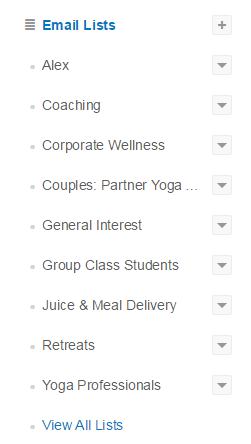 One of the easiest ways to segment your email list is to ask your contacts about their interests right when they sign up. In addition to asking for contact information, give them the option to check off their interests and establish what kind of updates they would like to receive from you.
In addition to interest, another great way to segment your list is by behavior. Use the reports from your previous email campaigns to better focus your next message.
Your click-through reports will tell you who is engaging with your emails and which content they are most interested in. If you’re consistently seeing a group of people clicking on links for a specific product or service but they haven’t made a purchase, you could create a special offer and encourage them to take action.
Or, set up an email series to teach them about the different services you offer with a tool like Autoresponder.
One of the easiest ways to segment your email list is to ask your contacts about their interests right when they sign up. In addition to asking for contact information, give them the option to check off their interests and establish what kind of updates they would like to receive from you.
In addition to interest, another great way to segment your list is by behavior. Use the reports from your previous email campaigns to better focus your next message.
Your click-through reports will tell you who is engaging with your emails and which content they are most interested in. If you’re consistently seeing a group of people clicking on links for a specific product or service but they haven’t made a purchase, you could create a special offer and encourage them to take action.
Or, set up an email series to teach them about the different services you offer with a tool like Autoresponder.
Website: Provide a focused message for new visitors
While your email list will include people that you already have pre-existing relationships with, your website is a probably a place where you’re mostly communicating with people who are new to your business. This can make it difficult to figure out who your target audience is. If you’re having trouble deciding how to position your business and all your different offerings, I suggest making a quick chart of all your different audiences and the challenges they are trying to solve. Then, look for areas for overlap — what do these people have in common and how can your business help? Imagine you own a catering business and offer services for a wide range of occasions. While the people interested in these services may be very different, there are some areas where their needs and interests will overlap. For example, regardless of the service they are looking for, they’ll be looking for someone who is credible and has some expertise. Include a strong mission statement on your website homepage, letting people know what your business is all about. You can show how you’ve helped customers in the past with customer testimonials. By telling a specific customer story, you’re empowering similar audiences to clearly envision how you can help them too. When considering which customer stories to share, try to emphasize the range of people you have helped. If you’re running a catering business, you might want to provide a testimonial from a larger occasion like a rehearsal dinner, a medium-sized event like a corporate boxed-lunch special, and then a small private gathering. With just those three testimonials, you’re showing audience members with different needs and budgets that your business can be a great fit.Social: Share a mix of quality content
Social media will have one of your most diverse audiences — ranging from your biggest fans who liked your Page to stay up-to-date with your latest information, to completely new customers who found you on social media with hopes of learning more about what you have to offer. Keep in mind that not everyone will be interested in every update you share. This is especially true on a high volume network like Twitter where people are seeing a constant flow of updates. That being said, you should look to narrow in on a target audience as much as possible. At Constant Contact, our audience spans a huge variety of industries, but two of the groups we talk to a lot are: small business and nonprofit marketers. On our social media channels, we focus on the information we know both businesses will be interested in: online marketing advice. But we also offer supporting content to appeal to small businesses or nonprofits more specifically.If you believe in yourself and your #smallbusiness, others will come to believe in you. pic.twitter.com/37gWpCalDZ
— Constant Contact (@ConstantContact) February 4, 2015
Although not everything we post relates to every member of our audience, this type of variety makes our content interesting and shows we are tuned in to both audiences. Now you’re talking! As you work to appeal to your different target audiences, you still want to ensure that your business’s brand is consistent and easily recognizable. This means you’ll be working with the same logo and color scheme for all your communications — no matter what the specific topic is. Try incorporating these ideas into your own marketing and see if you notice an increase in engagement. By treating your audience as individuals, while still promoting your business as a singular entity, you’ll quickly build trust within your audience and generate more business.Using Facebook For Your #Nonprofit in a "Bighearted" Way: http://t.co/I4cH1NbcxD via @PostPlanner
— Constant Contact (@ConstantContact) February 3, 2015
As a small business, relationships are at the heart of everything you do. You work hard to build customer relationships and to provide an experience that makes people want to come back again and again. It’s those loyal customers — the ones who know, like, and trust you — that help you grow by introducing your business to their friends, family members, and colleagues. This customer-centric approach likely played a big role in getting you from your first week of business to your first year of business, and any other milestones that followed. Building long-lasting customer relationships can take time, but there are also small things you can do to make a big impact on new and existing customers. We call these your WOW! moments.
What is a WOW! moment?
You have the power to provide experiences that WOW your customers. Unlike your larger competitors, you can empower your employees to do the “little” things that go above and beyond and create a memorable experience. These moments, which may seem small when they happen, can make a lasting impact on your customers — helping you turn new customers into repeat customers and longtime customers into loyal ambassadors for your business.What does a WOW! moment look like?
A WOW! moment can happen anywhere that people are interacting with your business — online or in person. It doesn’t have to be something big but it should be memorable and unique to your business. I recently experienced a WOW! moment when an employee at a newly opened shop noticed me looking through the window while I was out walking my dog, and invited us both in to look around. A simple act of kindness to my four-legged friend resulted in a new customer in their first week of business.How do you WOW! your customers?
This month, we’re going to be talking a lot about the different ways small businesses can WOW! their customers and build relationships that last. We want to hear from you! How do you WOW! your customers? What are the small but impactful things you do to put a smile on your customer’s face? We want to celebrate your success stories and help other businesses learn about the impact of a WOW! moment. We’ll be compiling our favorite tips and stories and will feature them later this month on the Constant Contact Blog.Share your story!
We’re making it easy to share your WOW! moments. Just choose the way that’s easiest for you:- Post your story in the comments below!
- Share your story on Facebook, Twitter, Instagram, or Google+ using the hashtag #CCWOW
- Email your story! Email socialsuccess@constantcontact.com.
- Visit the Constant Contact Facebook Page, and share your story there. (Or comment on the post below.)
“You need a Facebook strategy!” “Are you on Twitter yet?” “A blog can be a really helpful way to get your name and expertise out on the web.” As a small business, you’ve probably heard a lot of this before. And you nod your head and say, “Yes, of course,” because you know that everyone’s doing it. You might have a Facebook or LinkedIn page and some presence elsewhere on social media, but keeping it populated with lots of good content and features for your business…well that’s another story. You have much more on your plate than just figuring out what status update to put on Twitter. With that challenge in mind, here are five ways that your customers can help you create your content and make your social media more dynamic.
1. Write blog posts
Keeping up with a blog can be one of the harder things to do, but can be really helpful in allowing new customers to find you online. As opposed to a pithy 140-character statement or a fun shareable picture, a blog usually requires a few hundred words. Although this can seem like a big time commitment, you’re creating original content that can drive traffic to your website, show off your expertise, and build trust between you and your audience. One way to cut down on the time drain is to offer your blog as a way for your customers to contribute to your business. Using your social media following and email contacts, invite customers to apply to write guest posts on your blog. You can even choose a few blog ambassadors to write on your behalf. The extra benefit to this is that when people create content, they often want to share it even more, so before you know it, you have these bloggers writing entries and then sharing their experiences with your business all over the web!2. Contribute photos and other visual content
Visual content can be some of the most effective and shareable content. Ask your customers to share photos of themselves interacting with your product or to share event photos that are relevant to your business in some way. You can put the call-to-action out on social media or via email. If they share directly to your social media pages, suddenly you have a slew of great, engaging visual content and all you had to do was ask!3. Write online reviews
Many small businesses could benefit from more online reviews — whether that be on a site like Yelp, Angie’s List, or TripAdvisor. You always want your customers to write real authentic reviews and not put words in their mouths, but you can always make the suggestion via email or social media and let them know that they can find you on these sites. Oftentimes, customers have thought about writing the review, but they get busy and forget. The extra prompt of asking them will motivate them to take action and help you expand your presence online.4. Write testimonials
Could your website benefit from having customers tell their authentic stories of their experiences with you? Consider asking your customers to write a short testimonial for you. Ask customers on your email list if they’re willing to write short 1-3 sentence testimonials for you. This isn’t a very time consuming ask and you’ll acquire a lot of content for your website, blog, etc. Additionally, customers often like being featured, so they might be very open to and appreciative of having their name associated with a prominent feature on your website.5. Share your content on social media
Besides asking your customers to create content for you, you could partner with them to actually get greater awareness for the content you want to get out there. Provide easy ways for them to share, whether it’s asking customers to forward your monthly emails to a friend or posting a Facebook update and asking fans to share an offer. Make it really easy (and visually appealing) for fans to just click share on Facebook, Twitter, or LinkedIn.Put these tips to work!
Add a call to action in your email newsletter asking your customers to be your ambassadors for you. By selecting ambassadors, you can have a crew of people that create blog posts or share on social media on your behalf on a regular basis. You could also use social media to ask customers to share content such as your blog posts or discounts, or to submit photos and testimonials to you. Test out making these requests at different times of day or through different social networks to see which ways are most successful for you. Consider offering incentives to your customers for helping you with content or sharing on social media. A customer who shares your special offer the most on Facebook could be entitled to a discount or early access to a new product or service. These incentives don’t have to be anything major, they could be just small tokens of appreciation to thank your customers for helping your business to grow and succeed. In summary, content creation is hard whether you’re a one-person shop or a 20-employee retailer. Getting support from your customers will be a huge help, strengthen existing relationships, and reflect well on you. Your fans often want to help you succeed and are willing to offer up their skills, input, or followers to help you. Don’t underestimate the power of your customer base in expanding your content and building out your social media strategy. For more information on building a brand ambassador program, you can read my previous posts here. Or ask your questions in the comments below!Ali Hyatt leads marketing and product for Upward Labs, which creates software for businesses to build and manage brand ambassador programs to drive customer engagement and increase revenue and reach. Upward Labs is a former participant of Constant Contact’s Small Business Innovation Loft.
